SGS Thomson Microelectronics ST62T10M6-SWD, ST62T10M6-HWD, ST62T20M6-SWD, ST62T20M6-HWD, ST62T20B6-SWD Datasheet
...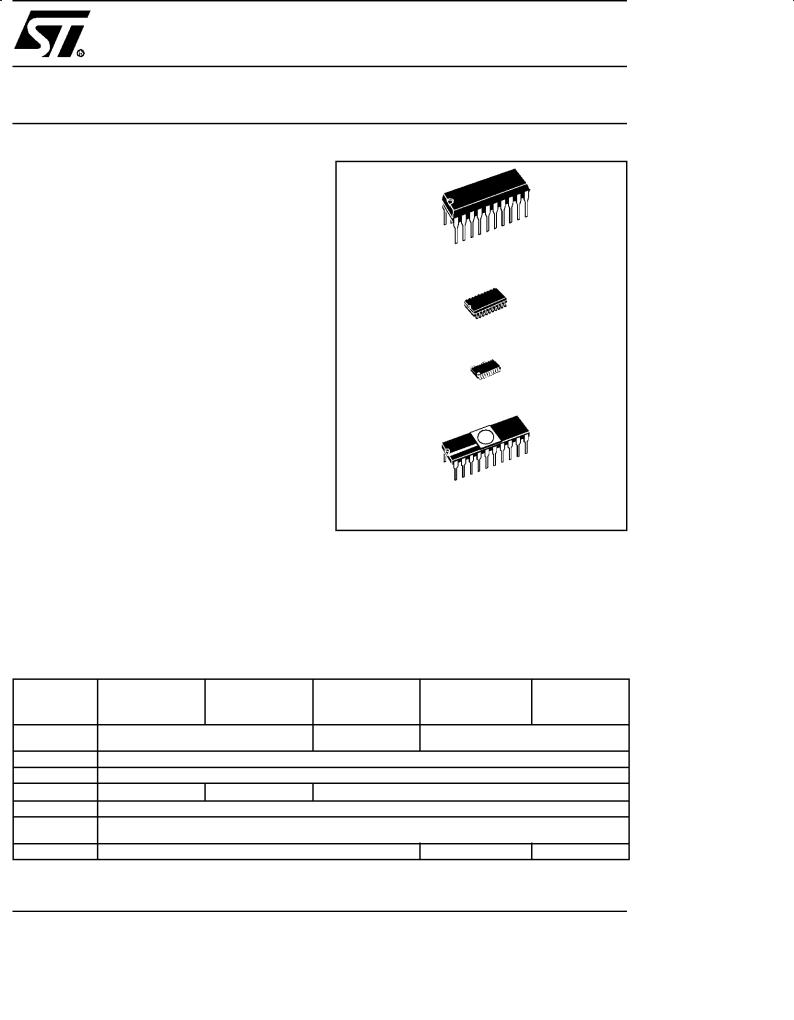
ST6208C/ST6209C
ST6210C/ST6220C
8-BIT MCUs WITH A/D CONVERTER, TWO TIMERS, OSCILLATOR SAFEGUARD & SAFE RESET
■Memories
±1K, 2K or 4K bytes Program memory (OTP, EPROM, FASTROM or ROM) with read-out protection
±64 bytes RAM
■Clock, Reset and Supply Management
±Enhanced reset system
±Low Voltage Detector (LVD) for Safe Reset
±Clock sources: crystal/ceramic resonator or RC network, external clock, backup oscillator (LFAO)
±Oscillator Safeguard (OSG)
±2 Power Saving Modes: Wait and Stop
■Interrupt Management
±4 interrupt vectors plus NMI and RESET
±12 external interrupt lines (on 2 vectors)
■12 I/O Ports
±12 multifunctional bidirectional I/O lines
±8 alternate function lines
±4 high sink outputs (20mA)
■2 Timers
±Configurable watchdog timer
±8-bit timer/counter with a 7-bit prescaler
■1 Analog peripheral
±8-bit ADC with 8 input channels (except on ST6208C)
PDIP20
SO20
SSOP20
CDIP20W
(See Section 12.5 for Ordering Information)
■Instruction Set
±8-bit data manipulation
±40 basic instructions
±9 addressing modes
±Bit manipulation
■Development Tools
±Full hardware/software development package
Device Summary
Features |
ST62T08C(OTP)/ |
ST62T09C(OTP)/ |
ST62T10C(OTP)/ |
ST62T20C(OTP) |
ST62E20C(EPROM) |
|
ST6208C(ROM) |
ST6209C (ROM) |
ST6210C (ROM) |
ST6220C(ROM) |
|||
|
||||||
|
ST62P08C(FASTROM) ST62P09C(FASTROM) ST62P10C(FASTROM) |
ST62P20C(FASTROM) |
|
|||
Program memory |
|
1K |
2K |
4K |
|
|
- bytes |
|
|
||||
|
|
|
|
|
||
RAM - bytes |
|
|
64 |
|
|
|
Operating Supply |
|
|
3.0V to 6V |
|
|
|
Analog Inputs |
- |
4 |
|
8 |
|
|
Clock Frequency |
|
|
8MHz Max |
|
|
|
Operating |
|
|
-40°C to +125°C |
|
|
|
Temperature |
|
|
|
|
||
|
|
|
|
|
||
Packages |
|
PDIP20/SO20/SSOP20 |
|
PDIP20/SO20 |
CDIP20W |
|
Rev. 3.0
June 2000 |
1/105 |

Table of Contents
1 INTRODUCTION . . . . . . . . . . . . . . . . . . . . . . . . . . . . . . . . . . . . . . . . . . . . . . . . . . . . . . . . . . . . . . 6 2 PIN DESCRIPTION . . . . . . . . . . . . . . . . . . . . . . . . . . . . . . . . . . . . . . . . . . . . . . . . . . . . . . . . . . . . 7 3 MEMORY MAPS, PROGRAMMING MODES AND OPTION BYTES . . . . . . . . . . . . . . . . . . . . . . 9
3.1 MEMORY AND REGISTER MAPS . . . . . . . . . . . . . . . . . . . . . . . . . . . . . . . . . . . . . . . . . . |
9 |
3.1.1 Introduction . . . . . . . . . . . . . . . . . . . . . . . . . . . . . . . . . . . . . . . . . . . . . . . . . . . . . . . . 9
3.1.2 Program Space . . . . . . . . . . . . . . . . . . . . . . . . . . . . . . . . . . . . . . . . . . . . . . . . . . . . 11
3.1.3 Readout Protection . . . . . . . . . . . . . . . . . . . . . . . . . . . . . . . . . . . . . . . . . . . . . . . . . 11
3.1.4 Data Space . . . . . . . . . . . . . . . . . . . . . . . . . . . . . . . . . . . . . . . . . . . . . . . . . . . . . . . 11
3.1.5 Stack Space . . . . . . . . . . . . . . . . . . . . . . . . . . . . . . . . . . . . . . . . . . . . . . . . . . . . . . . 11
3.1.6 Data ROM Window . . . . . . . . . . . . . . . . . . . . . . . . . . . . . . . . . . . . . . . . . . . . . . . . . 13
3.2 PROGRAMMING MODES . . . . . . . . . . . . . . . . . . . . . . . . . . . . . . . . . . . . . . . . . . . . . . . . 15
3.2.1 Program Memory . . . . . . . . . . . . . . . . . . . . . . . . . . . . . . . . . . . . . . . . . . . . . . . . . . . 15
3.2.2 EPROM Erasing . . . . . . . . . . . . . . . . . . . . . . . . . . . . . . . . . . . . . . . . . . . . . . . . . . . . 15
3.3 OPTION BYTES . . . . . . . . . . . . . . . . . . . . . . . . . . . . . . . . . . . . . . . . . . . . . . . . . . . . . . . 16
4 CENTRAL PROCESSING UNIT . . . . . . . . . . . . . . . . . . . . . . . . . . . . . . . . . . . . . . . . . . . . . . . . . |
17 |
|
4.1 |
INTRODUCTION . . . . . . . . . . . . . . . . . . . . . . . . . . . . . . . . . . . . . . . . . . . . . . . . . . . . . . . |
17 |
4.2 |
MAIN FEATURES . . . . . . . . . . . . . . . . . . . . . . . . . . . . . . . . . . . . . . . . . . . . . . . . . . . . . . |
17 |
4.3 |
CPU REGISTERS . . . . . . . . . . . . . . . . . . . . . . . . . . . . . . . . . . . . . . . . . . . . . . . . . . . . . . |
17 |
5 CLOCKS, SUPPLY AND RESET . . . . . . . . . . . . . . . . . . . . . . . . . . . . . . . . . . . . . . . . . . . . . . . . |
19 |
|
5.1 CLOCK SYSTEM . . . . . . . . . . . . . . . . . . . . . . . . . . . . . . . . . . . . . . . . . . . . . . . . . . . . . . . 19
5.1.1 Main Oscillator . . . . . . . . . . . . . . . . . . . . . . . . . . . . . . . . . . . . . . . . . . . . . . . . . . . . . 20 5.1.2 Oscillator Safeguard (OSG) . . . . . . . . . . . . . . . . . . . . . . . . . . . . . . . . . . . . . . . . . . . 21 5.1.3 Low Frequency Auxiliary Oscillator (LFAO) . . . . . . . . . . . . . . . . . . . . . . . . . . . . . . . 22 5.1.4 Register Description . . . . . . . . . . . . . . . . . . . . . . . . . . . . . . . . . . . . . . . . . . . . . . . . . 22 5.2 LOW VOLTAGE DETECTOR (LVD) . . . . . . . . . . . . . . . . . . . . . . . . . . . . . . . . . . . . . . . . 23
5.3 RESET . . . . . . . . . . . . . . . . . . . . . . . . . . . . . . . . . . . . . . . . . . . . . . . . . . . . . . . . . . . . . . . 24
|
5.3.1 |
Introduction . . . . . . . . . . . . . . . . . . . . . . . . . . . . . . . . . . . . . . . . . . . . . . . . . . . |
. . . . 24 |
|
5.3.2 |
RESET sequence . . . . . . . . . . . . . . . . . . . . . . . . . . . . . . . . . . . . . . . . . . . . . . |
. . . . 24 |
|
5.3.3 |
RESET Pin . . . . . . . . . . . . . . . . . . . . . . . . . . . . . . . . . . . . . . . . . . . . . . . . . . . . |
. . . . 25 |
|
5.3.4 |
Watchdog Reset . . . . . . . . . . . . . . . . . . . . . . . . . . . . . . . . . . . . . . . . . . . . . . . |
. . . . 26 |
|
5.3.5 |
LVD Reset . . . . . . . . . . . . . . . . . . . . . . . . . . . . . . . . . . . . . . . . . . . . . . . . . . . . |
. . . . 26 |
6 INTERRUPTS . . . . . . . . . . . . . . . . . . . . . . . . . . . . . . . . . . . . . . . . . . . . . . . . . . . . . . . . . . . |
. . . . 27 |
||
6.1 |
INTERRUPT RULES AND PRIORITY MANAGEMENT . . . . . . . . . . . . . . . . . . . . . |
. . . . 28 |
|
6.2 |
INTERRUPTS AND LOW POWER MODES . . . . . . . . . . . . . . . . . . . . . . . . . . . . . . |
. . . . 28 |
|
6.3 |
NON MASKABLE INTERRUPT . . . . . . . . . . . . . . . . . . . . . . . . . . . . . . . . . . . . . . . . |
. . . . 28 |
|
6.4 |
PERIPHERAL INTERRUPTS . . . . . . . . . . . . . . . . . . . . . . . . . . . . . . . . . . . . . . . . . |
. . . . 28 |
|
6.5 |
EXTERNAL INTERRUPTS (I/O PORTS) . . . . . . . . . . . . . . . . . . . . . . . . . . . . . . . . |
. . . . 29 |
|
|
6.5.1 |
Notes on using External Interrupts . . . . . . . . . . . . . . . . . . . . . . . . . . . . . . . . . . |
. . . . 29 |
6.6 |
INTERRUPT HANDLING PROCEDURE . . . . . . . . . . . . . . . . . . . . . . . . . . . . . . . . . |
. . . . 30 |
|
|
6.6.1 |
Interrupt Response Time . . . . . . . . . . . . . . . . . . . . . . . . . . . . . . . . . . . . . . . . . |
. . . . 30 |
6.7 |
REGISTER DESCRIPTION . . . . . . . . . . . . . . . . . . . . . . . . . . . . . . . . . . . . . . . . . . . |
. . . . 31 |
|
|
|
|
105 |
2/105

Table of Contents
7 POWER SAVING MODES . . . . . . . . . . . . . . . . . . . . . . . . . . . . . . . . . . . . . . . . . . . . . . . . . . . . . |
32 |
7.1 INTRODUCTION . . . . . . . . . . . . . . . . . . . . . . . . . . . . . . . . . . . . . . . . . . . . . . . . . . . . . . . 32 7.2 WAIT MODE . . . . . . . . . . . . . . . . . . . . . . . . . . . . . . . . . . . . . . . . . . . . . . . . . . . . . . . . . . 33 7.3 STOP MODE . . . . . . . . . . . . . . . . . . . . . . . . . . . . . . . . . . . . . . . . . . . . . . . . . . . . . . . . . . 34 7.4 NOTES RELATED TO WAIT AND STOP MODES . . . . . . . . . . . . . . . . . . . . . . . . . . . . . 36 7.4.1 Exit from Wait and Stop Modes . . . . . . . . . . . . . . . . . . . . . . . . . . . . . . . . . . . . . . . . 36 7.4.2 Recommended MCU Configuration . . . . . . . . . . . . . . . . . . . . . . . . . . . . . . . . . . . . . 36
8 I/O PORTS . . . . . . . . . . . . . . . . . . . . . . . . . . . . . . . . . . . . . . . . . . . . . . . . . . . . . . . . . . . . . . . . . . 37
8.1 |
INTRODUCTION . . . . . . . . . . . . . . . . . . . . . . . . . . . . . . . . . . . . . . . . . . . . . . . . . . . . . . . |
37 |
|
8.2 |
FUNCTIONAL DESCRIPTION . . . . . . . . . . . . . . . . . . . . . . . . . . . . . . . . . . . . . . . . . . . . |
37 |
|
|
8.2.1 |
Digital input modes . . . . . . . . . . . . . . . . . . . . . . . . . . . . . . . . . . . . . . . . . . . . . . . . . |
37 |
|
8.2.2 |
Analog inputs . . . . . . . . . . . . . . . . . . . . . . . . . . . . . . . . . . . . . . . . . . . . . . . . . . . . . . |
37 |
|
8.2.3 |
Output modes . . . . . . . . . . . . . . . . . . . . . . . . . . . . . . . . . . . . . . . . . . . . . . . . . . . . . |
37 |
|
8.2.4 |
Alternate functions . . . . . . . . . . . . . . . . . . . . . . . . . . . . . . . . . . . . . . . . . . . . . . . . . . |
37 |
|
8.2.5 Instructions NOT to be used to access Port Data registers (SET, RES, INC and DEC) 39 |
||
|
8.2.6 |
Recommendations . . . . . . . . . . . . . . . . . . . . . . . . . . . . . . . . . . . . . . . . . . . . . . . . . . |
39 |
8.3 |
LOW POWER MODES . . . . . . . . . . . . . . . . . . . . . . . . . . . . . . . . . . . . . . . . . . . . . . . . . . |
39 |
|
8.4 |
INTERRUPTS . . . . . . . . . . . . . . . . . . . . . . . . . . . . . . . . . . . . . . . . . . . . . . . . . . . . . . . . . |
39 |
|
8.5 |
REGISTER DESCRIPTION . . . . . . . . . . . . . . . . . . . . . . . . . . . . . . . . . . . . . . . . . . . . . . . |
41 |
|
9 ON-CHIP PERIPHERALS . . . . . . . . . . . . . . . . . . . . . . . . . . . . . . . . . . . . . . . . . . . . . . . . . . . . . . |
42 |
||
9.1 |
WATCHDOG TIMER (WDG) . . . . . . . . . . . . . . . . . . . . . . . . . . . . . . . . . . . . . . . . . . . . . . |
42 |
|
|
9.1.1 |
Introduction . . . . . . . . . . . . . . . . . . . . . . . . . . . . . . . . . . . . . . . . . . . . . . . . . . . . . . . |
42 |
|
9.1.2 |
Main Features . . . . . . . . . . . . . . . . . . . . . . . . . . . . . . . . . . . . . . . . . . . . . . . . . . . . . |
42 |
|
9.1.3 |
Functional Description . . . . . . . . . . . . . . . . . . . . . . . . . . . . . . . . . . . . . . . . . . . . . . . |
43 |
|
9.1.4 |
Recommendations . . . . . . . . . . . . . . . . . . . . . . . . . . . . . . . . . . . . . . . . . . . . . . . . . . |
43 |
|
9.1.5 |
Low Power Modes . . . . . . . . . . . . . . . . . . . . . . . . . . . . . . . . . . . . . . . . . . . . . . . . . . |
44 |
|
9.1.6 |
Interrupts . . . . . . . . . . . . . . . . . . . . . . . . . . . . . . . . . . . . . . . . . . . . . . . . . . . . . . . . . |
44 |
|
9.1.7 |
Register Description . . . . . . . . . . . . . . . . . . . . . . . . . . . . . . . . . . . . . . . . . . . . . . . . . |
45 |
9.2 |
8-BIT TIMER . . . . . . . . . . . . . . . . . . . . . . . . . . . . . . . . . . . . . . . . . . . . . . . . . . . . . . . . . . |
46 |
|
|
9.2.1 |
Introduction . . . . . . . . . . . . . . . . . . . . . . . . . . . . . . . . . . . . . . . . . . . . . . . . . . . . . . . |
46 |
|
9.2.2 |
Main Features . . . . . . . . . . . . . . . . . . . . . . . . . . . . . . . . . . . . . . . . . . . . . . . . . . . . . |
46 |
|
9.2.3 |
Counter/Prescaler Description . . . . . . . . . . . . . . . . . . . . . . . . . . . . . . . . . . . . . . . . . |
47 |
|
9.2.4 |
Functional Description . . . . . . . . . . . . . . . . . . . . . . . . . . . . . . . . . . . . . . . . . . . . . . . |
48 |
|
9.2.5 |
Low Power Modes . . . . . . . . . . . . . . . . . . . . . . . . . . . . . . . . . . . . . . . . . . . . . . . . . . |
50 |
|
9.2.6 |
Interrupts . . . . . . . . . . . . . . . . . . . . . . . . . . . . . . . . . . . . . . . . . . . . . . . . . . . . . . . . . |
50 |
|
9.2.7 |
Register Description . . . . . . . . . . . . . . . . . . . . . . . . . . . . . . . . . . . . . . . . . . . . . . . . . |
51 |
9.3 |
A/D CONVERTER (ADC) . . . . . . . . . . . . . . . . . . . . . . . . . . . . . . . . . . . . . . . . . . . . . . . . |
52 |
|
9.3.1 Introduction . . . . . . . . . . . . . . . . . . . . . . . . . . . . . . . . . . . . . . . . . . . . . . . . . . . . . . . 52 9.3.2 Main Features . . . . . . . . . . . . . . . . . . . . . . . . . . . . . . . . . . . . . . . . . . . . . . . . . . . . . 52 9.3.3 Functional description . . . . . . . . . . . . . . . . . . . . . . . . . . . . . . . . . . . . . . . . . . . . . . . 53 9.3.4 Recommendations . . . . . . . . . . . . . . . . . . . . . . . . . . . . . . . . . . . . . . . . . . . . . . . . . . 54 9.3.5 Low power modes . . . . . . . . . . . . . . . . . . . . . . . . . . . . . . . . . . . . . . . . . . . . . . . . . . 55 9.3.6 Interrupts . . . . . . . . . . . . . . . . . . . . . . . . . . . . . . . . . . . . . . . . . . . . . . . . . . . . . . . . . 55 9.3.7 Register description . . . . . . . . . . . . . . . . . . . . . . . . . . . . . . . . . . . . . . . . . . . . . . . . . 55
3/105

Table of Contents
10 INSTRUCTION SET . . . . . . . . . . . . . . . . . . . . . . . . . . . . . . . . . . . . . . . . . . . . . . . . . . . . . . . . . |
56 |
10.1 ST6 ARCHITECTURE . . . . . . . . . . . . . . . . . . . . . . . . . . . . . . . . . . . . . . . . . . . . . . . . . . . 56 10.2 ADDRESSING MODES . . . . . . . . . . . . . . . . . . . . . . . . . . . . . . . . . . . . . . . . . . . . . . . . . . 56 10.3 INSTRUCTION SET . . . . . . . . . . . . . . . . . . . . . . . . . . . . . . . . . . . . . . . . . . . . . . . . . . . . 57
11 ELECTRICAL CHARACTERISTICS . . . . . . . . . . . . . . . . . . . . . . . . . . . . . . . . . . . . . . . . . . . . . 62
11.1 PARAMETER CONDITIONS . . . . . . . . . . . . . . . . . . . . . . . . . . . . . . . . . . . . . . . . . . . . . . 62
11.1.1Minimum and Maximum values . . . . . . . . . . . . . . . . . . . . . . . . . . . . . . . . . . . . . . . . 62 11.1.2Typical values . . . . . . . . . . . . . . . . . . . . . . . . . . . . . . . . . . . . . . . . . . . . . . . . . . . . . 62 11.1.3Typical curves . . . . . . . . . . . . . . . . . . . . . . . . . . . . . . . . . . . . . . . . . . . . . . . . . . . . . 62 11.1.4Loading capacitor . . . . . . . . . . . . . . . . . . . . . . . . . . . . . . . . . . . . . . . . . . . . . . . . . . . 62 11.1.5Pin input voltage . . . . . . . . . . . . . . . . . . . . . . . . . . . . . . . . . . . . . . . . . . . . . . . . . . . 62
11.2 ABSOLUTE MAXIMUM RATINGS . . . . . . . . . . . . . . . . . . . . . . . . . . . . . . . . . . . . . . . . . 63
|
11.2.1Voltage Characteristics . . . . . . . . . . . . . . . . . . . . . . . . . . . . . . . . . . . . . . . . . . . . . . |
63 |
|
11.2.2Current Characteristics . . . . . . . . . . . . . . . . . . . . . . . . . . . . . . . . . . . . . . . . . . . . . . |
63 |
|
11.2.3Thermal Characteristics . . . . . . . . . . . . . . . . . . . . . . . . . . . . . . . . . . . . . . . . . . . . . |
63 |
11.3 |
OPERATING CONDITIONS . . . . . . . . . . . . . . . . . . . . . . . . . . . . . . . . . . . . . . . . . . . . . . |
64 |
|
11.3.1General Operating Conditions . . . . . . . . . . . . . . . . . . . . . . . . . . . . . . . . . . . . . . . . |
64 |
|
11.3.2Operating Conditions with Low Voltage Detector (LVD) . . . . . . . . . . . . . . . . . . . . . |
65 |
11.4 |
SUPPLY CURRENT CHARACTERISTICS . . . . . . . . . . . . . . . . . . . . . . . . . . . . . . . . . . . |
66 |
|
11.4.1RUN Modes . . . . . . . . . . . . . . . . . . . . . . . . . . . . . . . . . . . . . . . . . . . . . . . . . . . . . . |
66 |
|
11.4.2WAIT Modes . . . . . . . . . . . . . . . . . . . . . . . . . . . . . . . . . . . . . . . . . . . . . . . . . . . . . . |
67 |
|
11.4.3STOP Mode . . . . . . . . . . . . . . . . . . . . . . . . . . . . . . . . . . . . . . . . . . . . . . . . . . . . . . |
70 |
|
11.4.4Supply and Clock System . . . . . . . . . . . . . . . . . . . . . . . . . . . . . . . . . . . . . . . . . . . . |
71 |
|
11.4.5On-Chip Peripherals . . . . . . . . . . . . . . . . . . . . . . . . . . . . . . . . . . . . . . . . . . . . . . . . |
71 |
11.5 |
CLOCK AND TIMING CHARACTERISTICS . . . . . . . . . . . . . . . . . . . . . . . . . . . . . . . . . . |
72 |
11.5.1General Timings . . . . . . . . . . . . . . . . . . . . . . . . . . . . . . . . . . . . . . . . . . . . . . . . . . . 72 11.5.2External Clock Source . . . . . . . . . . . . . . . . . . . . . . . . . . . . . . . . . . . . . . . . . . . . . . . 72 11.5.3Crystal and Ceramic Resonator Oscillators . . . . . . . . . . . . . . . . . . . . . . . . . . . . . . . 73 11.5.4RC Oscillator . . . . . . . . . . . . . . . . . . . . . . . . . . . . . . . . . . . . . . . . . . . . . . . . . . . . . . 74 11.5.5Oscillator Safeguard (OSG) and Low Frequency Auxiliary Oscillator (LFAO) . . . . . 75
11.6 MEMORY CHARACTERISTICS . . . . . . . . . . . . . . . . . . . . . . . . . . . . . . . . . . . . . . . . . . . 76
11.6.1RAM and Hardware Registers . . . . . . . . . . . . . . . . . . . . . . . . . . . . . . . . . . . . . . . . |
76 |
11.6.2EPROM Program Memory . . . . . . . . . . . . . . . . . . . . . . . . . . . . . . . . . . . . . . . . . . . |
76 |
11.7 EMC CHARACTERISTICS . . . . . . . . . . . . . . . . . . . . . . . . . . . . . . . . . . . . . . . . . . . . . . . |
77 |
11.7.1Functional EMS . . . . . . . . . . . . . . . . . . . . . . . . . . . . . . . . . . . . . . . . . . . . . . . . . . . . 77 11.7.2Absolute Electrical Sensitivity . . . . . . . . . . . . . . . . . . . . . . . . . . . . . . . . . . . . . . . . . 78 11.7.3ESD Pin Protection Strategy . . . . . . . . . . . . . . . . . . . . . . . . . . . . . . . . . . . . . . . . . . 80 11.8 I/O PORT PIN CHARACTERISTICS . . . . . . . . . . . . . . . . . . . . . . . . . . . . . . . . . . . . . . . . 81
11.8.1General Characteristics . . . . . . . . . . . . . . . . . . . . . . . . . . . . . . . . . . . . . . . . . . . . . . 81 11.8.2Output Driving Current . . . . . . . . . . . . . . . . . . . . . . . . . . . . . . . . . . . . . . . . . . . . . . . 82 11.9 CONTROL PIN CHARACTERISTICS . . . . . . . . . . . . . . . . . . . . . . . . . . . . . . . . . . . . . . . 85
11.9.1Asynchronous RESET Pin . . . . . . . . . . . . . . . . . . . . . . . . . . . . . . . . . . . . . . . . . . . . 85 11.9.2NMI Pin . . . . . . . . . . . . . . . . . . . . . . . . . . . . . . . . . . . . . . . . . . . . . . . . . . . . . . . . . . 86
105
4/105

Table of Contents
11.10 TIMER PERIPHERAL CHARACTERISTICS . . . . . . . . . . . . . . . . . . . . . . . . . . . . . . . . . . 87
11.10.1Watchdog Timer . . . . . . . . . . . . . . . . . . . . . . . . . . . . . . . . . . . . . . . . . . . . . . . . . . 87 11.10.28-Bit Timer . . . . . . . . . . . . . . . . . . . . . . . . . . . . . . . . . . . . . . . . . . . . . . . . . . . . . . . 87 11.11 8-BIT ADC CHARACTERISTICS . . . . . . . . . . . . . . . . . . . . . . . . . . . . . . . . . . . . . . . . . . 88
12 GENERAL INFORMATION . . . . . . . . . . . . . . . . . . . . . . . . . . . . . . . . . . . . . . . . . . . . . . . . . . . . 90
12.1 PACKAGE MECHANICAL DATA . . . . . . . . . . . . . . . . . . . . . . . . . . . . . . . . . . . . . . . . . . 90 12.2 THERMAL CHARACTERISTICS . . . . . . . . . . . . . . . . . . . . . . . . . . . . . . . . . . . . . . . . . . 92 12.3 SOLDERING AND GLUEABILITY INFORMATION . . . . . . . . . . . . . . . . . . . . . . . . . . . . . 93 12.4 PACKAGE/SOCKET FOOTPRINT PROPOSAL . . . . . . . . . . . . . . . . . . . . . . . . . . . . . . . 94 12.5 ORDERING INFORMATION . . . . . . . . . . . . . . . . . . . . . . . . . . . . . . . . . . . . . . . . . . . . . . 95 12.6 TRANSFER OF CUSTOMER CODE . . . . . . . . . . . . . . . . . . . . . . . . . . . . . . . . . . . . . . . 96
12.6.1FASTROM version . . . . . . . . . . . . . . . . . . . . . . . . . . . . . . . . . . . . . . . . . . . . . . . . . . 96 12.6.2ROM VERSION . . . . . . . . . . . . . . . . . . . . . . . . . . . . . . . . . . . . . . . . . . . . . . . . . . . . 98
13 DEVELOPMENT TOOLS . . . . . . . . . . . . . . . . . . . . . . . . . . . . . . . . . . . . . . . . . . . . . . . . . . . . 100 14 ST6 APPLICATION NOTES . . . . . . . . . . . . . . . . . . . . . . . . . . . . . . . . . . . . . . . . . . . . . . . . . . 102 15 SUMMARY OF CHANGES . . . . . . . . . . . . . . . . . . . . . . . . . . . . . . . . . . . . . . . . . . . . . . . . . . . 104 16 TO GET MORE INFORMATION . . . . . . . . . . . . . . . . . . . . . . . . . . . . . . . . . . . . . . . . . . . . . . . 104
5/105
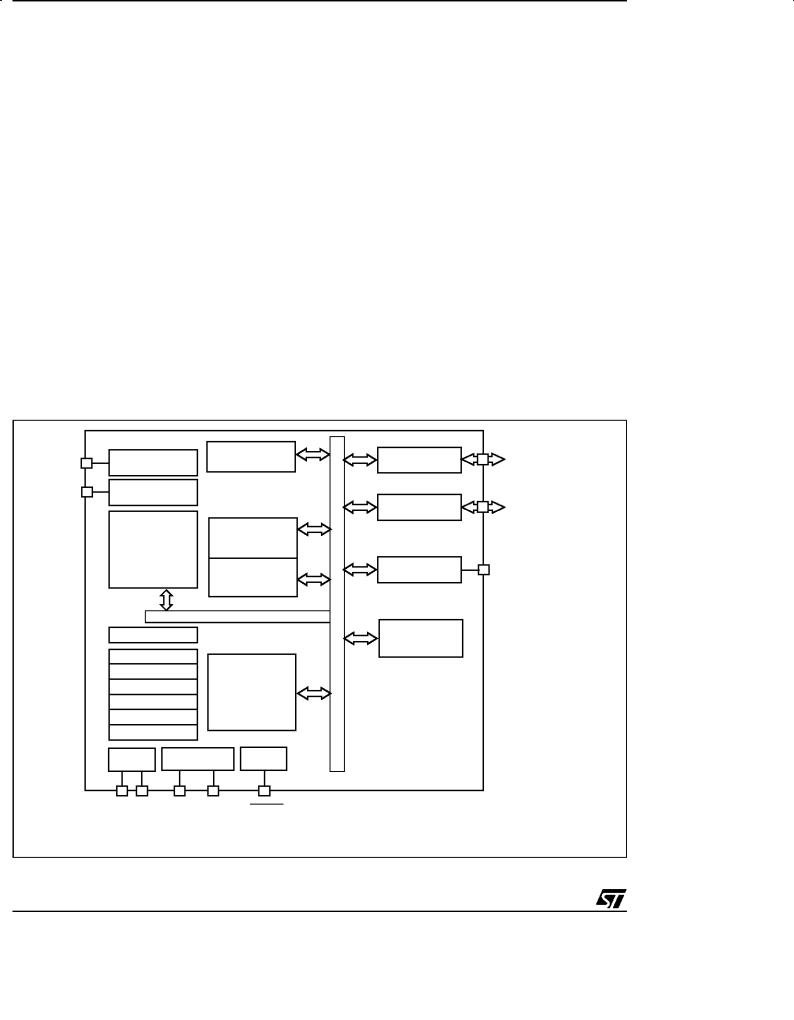
ST6208C/ST6209C/ST6210C/ST6220C
1 INTRODUCTION
The ST6208C, 09C, 10C and 20C devices are low cost members of the ST62xx 8-bit HCMOS family of microcontrollers, which is targeted at low to medium complexity applications. All ST62xx devices are based on a building block approach: a common core is surrounded by a number of on-chip peripherals.
The ST62E20C is the erasable EPROM version of the ST62T08C, T09C, T10C and T20C devices, which may be used during the development phase for the ST62T08C, T09C, T10C and T20C target devices, as well as the respective ST6208C, 09C, 10C and 20C ROM devices.
OTP and EPROM devices are functionally identical. OTP devices offer all the advantages of user programmability at low cost, which make them the ideal choice in a wide range of applications where frequent code changes, multiple code versions or last minute programmability are required.
The ROM based versions offer the same functionality, selecting the options defined in the program-
Figure 1. Block Diagram
mable option bytes of the OTP/EPROM versions in the ROM option list (See Section 12.6 on page 96).
The ST62P08C/P09C/P10C/P20C are the Factory Advanced Service Technique ROM (FASTROM) versions of ST62T08C, T09C, T10C and T20C OTP devices.
They offer the same functionality as OTP devices, but they do not have to be programmed by the customer (See Section 12 on page 90).
These compact low-cost devices feature a Timer comprising an 8-bit counter with a 7-bit programmable prescaler, an 8-bit A/D Converter with up to 8 analog inputs (depending on device) and a Digital Watchdog timer, making them well suited for a wide range of automotive, appliance and industrial applications.
For easy reference, all parametric data are located in Section 11 on page 62.
TEST/ VPP |
TEST |
NMI |
INTERRUPTS |
|
PROGRAM |
|
: |
|
MEMORY |
|
(1K, 2K |
|
or 4K Bytes) |
|
PC |
|
STACK LEVEL 1 |
|
STACK LEVEL 2 |
|
STACK LEVEL 3 |
|
STACK LEVEL 4 |
|
STACK LEVEL 5 |
|
STACK LEVEL 6 |
8-BIT *
A/D CONVERTE R
DATA ROM
USER
SELECTABLE
DATA RAM
64 Bytes
8-BIT CORE
POWER OSCILLATOR RESET
SUPPLY
VDD VSS OSCin OSCout RESET
* Depending on device. See device summary on page 1.
PORT A |
PA0..PA3 (20mA Sink) |
|
|
PORT B |
PB0..PB7 / Ain* |
TIMER |
TIMER |
WATCHDOG |
|
TIMER |
|
6/105
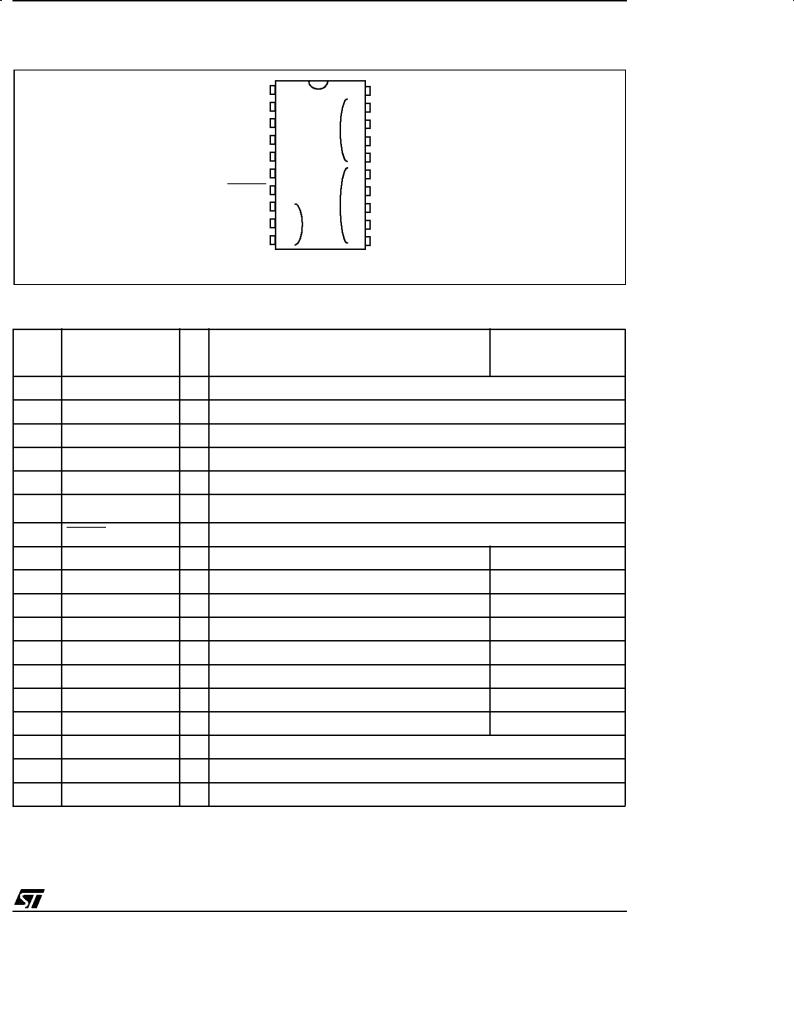
ST6208C/ST6209C/ST6210C/ST6220C
2 PIN DESCRIPTION
Figure 2. 20-Pin Package Pinout
VDD |
1 |
|
|
20 |
VSS |
TIMER |
2 |
|
|
19 |
PA0/20mA Sink |
OSCin |
3 |
|
it1 |
18 |
PA1/20mA Sink |
OSCout |
4 |
|
|
17 |
PA2/20mA Sink |
NMI |
5 |
|
|
16 |
PA3/20mA Sink |
VPP/TEST |
6 |
|
|
15 |
PB0/Ain* |
RESET |
7 |
|
it2 |
14 |
PB1/Ain* |
Ain*/PB7 |
8 |
|
13 |
PB2/Ain* |
|
Ain*/PB6 |
9 |
it2 |
|
12 |
PB3/Ain* |
Ain*/PB5 |
10 |
|
|
11 |
PB4/Ain* |
itX associated interrupt vector
* Depending on device. See device summary on page 1
Table 1. Device Pin Description
Pin n° |
Pin Name |
1VDD
2TIMER
3OSCin
4OSCout
5NMI
6VPP/TEST
7RESET
8PB7/Ain*
9PB6/Ain*
10PB5/Ain*
11PB4/Ain*
12PB3/Ain*
13PB2/Ain*
14PB1/Ain*
15PB0/Ain*
16PA3/ 20mA Sink
17PA2/ 20mA Sink
18PA1/ 20mA Sink
Type |
Main Function |
Alternate Function |
|
(after Reset) |
|
|
|
|
S |
Main power supply |
|
I/O |
Timer input or output |
|
I |
External clock input or resonator oscillator inverter input |
|
O |
Resonator oscillator inverter output or resistor input for RC oscillator |
|
I |
Non maskable interrupt (falling edge sensitive) |
|
|
Must be held at Vss for normal operation, if a 12.5V level is applied to the pin |
|
|
during the reset phase, the device enters EPROM programming mode. |
|
I/O |
Top priority non maskable interrupt (active low) |
|
I/O |
Pin B7 (IPU) |
Analog input |
I/O |
Pin B6 (IPU) |
Analog input |
I/O |
Pin B5 (IPU) |
Analog input |
I/O |
Pin B4 (IPU) |
Analog input |
I/O |
Pin B3 (IPU) |
Analog input |
I/O |
Pin B2 (IPU) |
Analog input |
I/O |
Pin B1 (IPU) |
Analog input |
I/O |
Pin B0 (IPU) |
Analog input |
I/O |
Pin A3 (IPU) |
|
I/O |
Pin A2 (IPU) |
|
I/O |
Pin A1 (IPU) |
|
7/105

ST6208C/ST6209C/ST6210C/ST6220C
Pin n° |
Pin Name |
19PA0/ 20mA Sink
20VSS
Type |
|
I/O |
Pin A0 (IPU) |
S |
Ground |
Main Function |
Alternate Function |
|
(after Reset) |
||
|
Legend / Abbreviations for Table 1:
* Depending on device. See device summary on page 1. I = input, O = output, S = supply, IPU = input with pull-up
The input with pull-up configuration (reset state) is valid as long as the user software does not change it. Refer to Section 8 ºI/O PORTSº on page 37 for more details on the software configuration of the I/O ports.
8/105
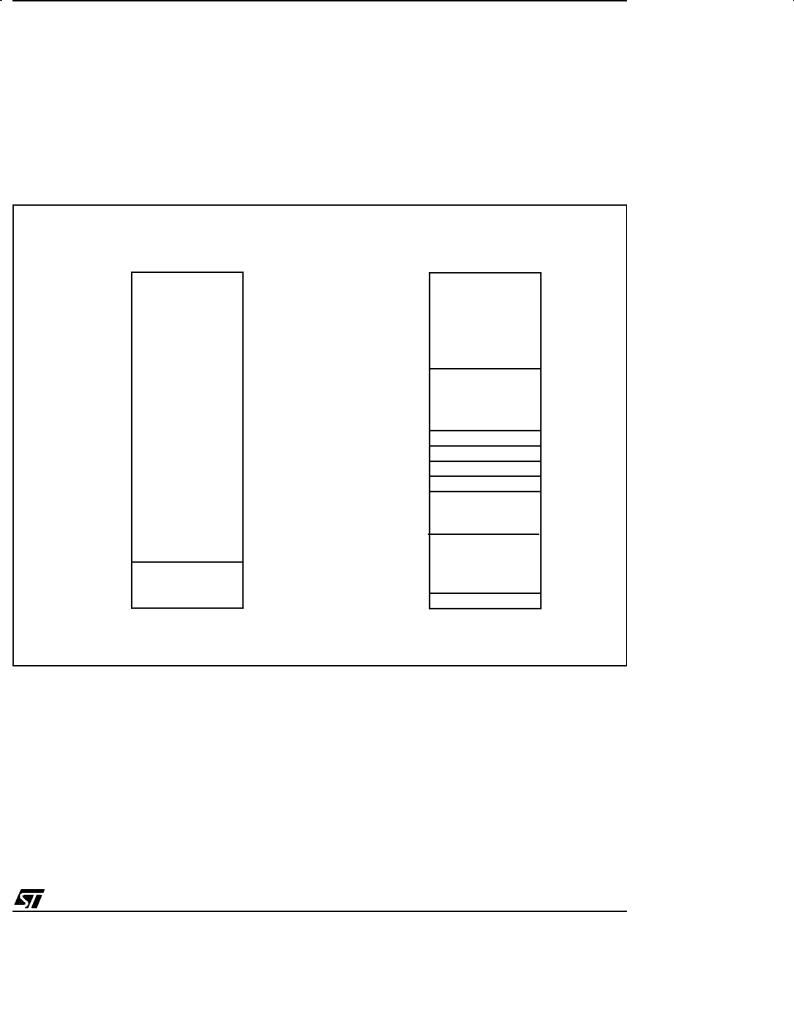
ST6208C/ST6209C/ST6210C/ST6220C
3 MEMORY MAPS, PROGRAMMING MODES AND OPTION BYTES
3.1 MEMORY AND REGISTER MAPS
3.1.1 Introduction
The MCU operates in three separate memory spaces: Program space, Data space, and Stack space. Operation in these three memory spaces is described in the following paragraphs.
Figure 3. Memory Addressing Diagram
Briefly, Program space contains user program code in OTP and user vectors; Data space contains user data in RAM and in OTP, and Stack space accommodates six levels of stack for subroutine and interrupt service routine nesting.
PROGRAM SPACE |
|
DATA SPACE |
|
|
|
||
000h |
000h |
|
|
|
|
||
|
|
RESERVED |
|
|
03Fh |
|
|
|
040h |
|
|
|
|
DATA ROM |
|
PROGRAM |
|
WINDOW |
|
MEMORY |
07Fh |
|
|
(see Figure 4) |
080h |
X REGISTER |
|
081h |
Y REGISTER |
||
|
|||
|
082h |
V REGISTER |
|
|
083h |
W REGISTER |
|
|
084h |
|
|
|
0BFh |
RAM |
|
|
|
||
0FF0h |
0C0h |
HARDWARE |
|
|
CONTROL |
||
INTERRUPT & |
|
REGISTERS |
|
|
(see Table 2) |
||
RESET VECTORS |
|
||
|
ACCUMULATOR |
||
0FFFh |
0FFh |
9/105

ST6208C/ST6209C/ST6210C/ST6220C
MEMORY MAP (Cont'd)
Figure 4. Program Memory Map
ST6208C, 09C |
ST6210C |
0000h |
0000h |
NOT IMPLEMENTED
NOT IMPLEMENTED
07FFh
0800h
RESERVED*
|
|
087Fh |
|
|
|
|
0880h |
|
|
0AFFh |
|
|
|
|
0B00h |
|
|
|
|
0B9Fh |
RESERVED* |
|
USER |
|
|
|
|||
0BA0h |
|
|
PROGRAM MEMORY |
|
|
USER |
|
1824 BYTES |
|
|
|
|
||
|
PROGRAM MEMORY |
|
|
|
|
1024 BYTES |
|
|
|
0F9Fh |
|
0F9Fh |
|
|
0FA0h |
RESERVED* |
0FA0h |
RESERVED* |
|
0FEFh |
0FEFh |
|||
|
|
|||
0FF0h |
INTERRUPT VECTORS |
0FF0h |
INTERRUPT VECTORS |
|
0FF7h |
0FF7h |
|||
|
|
|||
0FF8h |
RESERVED* |
0FF8h |
RESERVED* |
|
0FFBh |
|
0FFBh |
|
|
0FFCh |
NMI VECTOR |
0FFCh |
NMI VECTOR |
|
0FFDh |
0FFDh |
|||
|
|
|||
0FFEh |
USER RESET VECTOR |
0FFEh |
USER RESET VECTOR |
|
0FFFh |
|
0FFFh |
|
(*) Reserved areas should be filled with 0FFh
ST6220C
0000h
RESERVED*
07Fh
080h
USER
PROGRAM MEMORY
3872 BYTES
0F9Fh |
|
|
0FA0h |
RESERVED* |
|
0FEFh |
||
|
||
0FF0h |
INTERRUPT VECTORS |
|
0FF7h |
||
|
||
0FF8h |
RESERVED* |
|
0FFBh |
|
|
0FFCh |
NMI VECTOR |
|
0FFDh |
||
|
||
0FFEh |
USER RESET VECTOR |
|
0FFFh |
|
10/105

MEMORY MAP (Cont'd)
3.1.2 Program Space
Program Space comprises the instructions to be executed, the data required for immediate addressing mode instructions, the reserved factory test area and the user vectors. Program Space is addressed via the 12-bit Program Counter register (PC register). Thus, the MCU is capable of addressing 4K bytes of memory directly.
3.1.3 Readout Protection
The Program Memory in OTP, EPROM or ROM devices can be protected against external readout of memory by setting the Readout Protection bit in the option bytes (Section 3.3 on page 16).
In the EPROM parts, Readout Protection option can be desactivated only by U.V. erasure that also results in the whole EPROM context being erased.
Note: Once the Readout Protection is activated, it is no longer possible, even for STMicroelectronics, to gain access to the OTP or ROM contents. Returned parts can therefore not be accepted if the Readout Protection bit is set.
3.1.4 Data Space
Data Space accommodates all the data necessary for processing the user program. This space comprises the RAM resource, the processor core and peripheral registers, as well as read-only data
ST6208C/ST6209C/ST6210C/ST6220C
such as constants and look-up tables in OTP/ EPROM.
3.1.4.1 Data ROM
All read-only data is physically stored in program memory, which also accommodates the Program Space. The program memory consequently contains the program code to be executed, as well as the constants and look-up tables required by the application.
The Data Space locations in which the different constants and look-up tables are addressed by the processor core may be thought of as a 64-byte window through which it is possible to access the read-only data stored in OTP/EPROM.
3.1.4.2 Data RAM
The data space includes the user RAM area, the accumulator (A), the indirect registers (X), (Y), the short direct registers (V), (W), the I/O port registers, the peripheral data and control registers, the interrupt option register and the Data ROM Window register (DRWR register).
3.1.5 Stack Space
Stack space consists of six 12-bit registers which are used to stack subroutine and interrupt return addresses, as well as the current program counter contents.
11/105
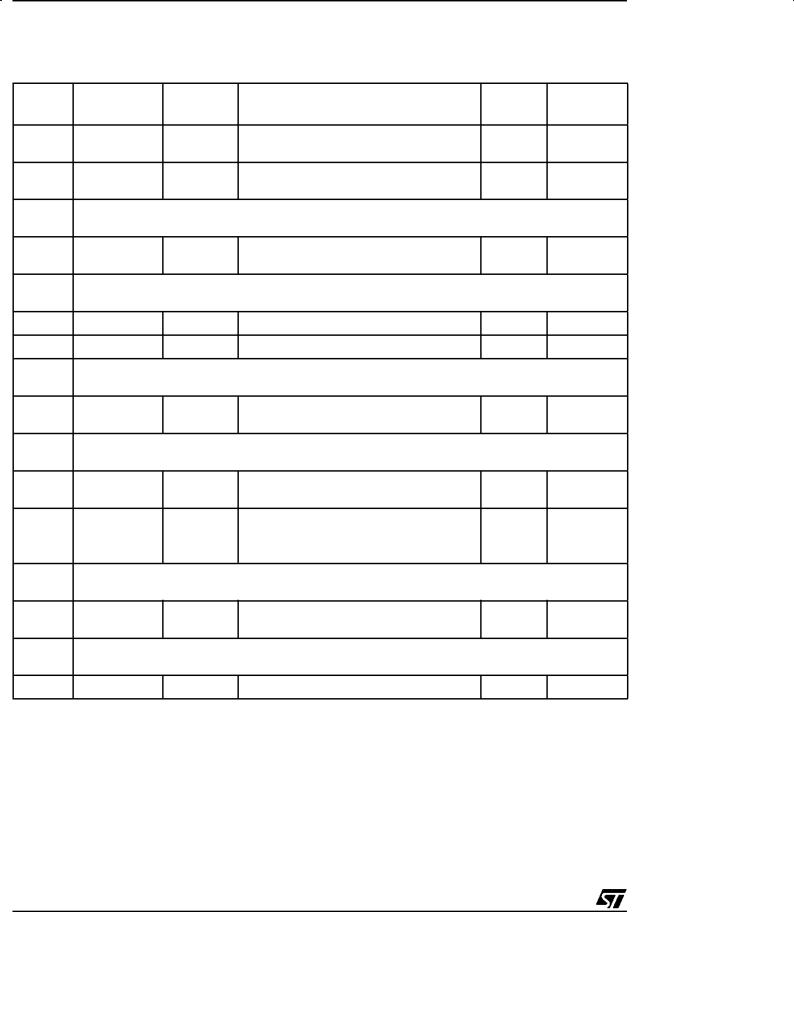
ST6208C/ST6209C/ST6210C/ST6220C
MEMORY MAP (Cont'd)
Table 2. Hardware Register Map
Address
080h to 083h
0C0h
0C1h
0C2h
0C3h
0C4h
0C5h
0C6h
0C7h
0C8h
0C9h
0CAh
0CBh
0CCh
0CDh
0CEh
0CFh
0D0h
0D1h
0D2h
0D3h
0D4h
0D5h to 0D7h
0D8h
0D9h to 0FEh
0FF
Block
CPU
I/O Ports
I/O Ports
I/O Ports
ADC 4)
Timer1
Watchdog
Timer
CPU
Register |
Register Name |
Reset |
Remarks |
|
Label |
Status |
|||
|
|
|||
X,Y,V,W |
X,Y index registers |
xxh |
R/W |
|
V,W short direct registers |
||||
|
|
|
||
DRA 1) 2) 3) |
Port A Data Register |
00h |
R/W |
|
DRB 1) 2) 3) |
Port B Data Register |
00h |
R/W |
|
|
Reserved (2 Bytes) |
|
|
|
DDRA 2) |
Port A Direction Register |
00h |
R/W |
|
DDRB 2) |
Port B Direction Register |
00h |
R/W |
|
|
Reserved (2 Bytes) |
|
|
|
IOR |
Interrupt Option Register |
xxh |
Write-only |
|
DRWR |
Data ROM Window register |
xxh |
Write-only |
|
|
Reserved (2 Bytes) |
|
|
|
ORA 2) |
Port A Option Register |
00h |
R/W |
|
ORB 2) |
Port B Option Register |
00h |
R/W |
|
|
Reserved (2 bytes) |
|
|
|
ADR |
A/D Converter Data Register |
xxh |
Read-only |
|
ADCR |
A/D Converter Control Register |
40h |
Ro/Wo |
|
PSCR |
Timer 1 Prescaler Register |
7Fh |
R/W |
|
TCR |
Timer 1 Downcounter Register |
0FFh |
R/W |
|
TSCR |
Timer 1 Status Control Register |
00h |
R/W |
|
|
Reserved (3 Bytes) |
|
|
|
WDGR |
Watchdog Register |
0FEh |
R/W |
|
|
Reserved (38 Bytes) |
|
|
|
A |
Accumulator |
xxh |
R/W |
Legend:
x = undefined, R/W = Read/Write, Ro = Read-only Bit(s) in the register, Wo = Write-only Bit(s) in the register.
Notes:
1.The contents of the I/O port DR registers are readable only in output configuration. In input configuration, the values of the I/O pins are returned instead of the DR register contents.
2.The bits associated with unavailable pins must always be kept at their reset value.
3.Do not use single-bit instructions (SET, RES...) on Port Data Registers if any pin of the port is configured in input mode (refer to Section 8 ºI/O PORTSº on page 37 for more details)
4.Depending on device. See device summary on page 1.
12/105
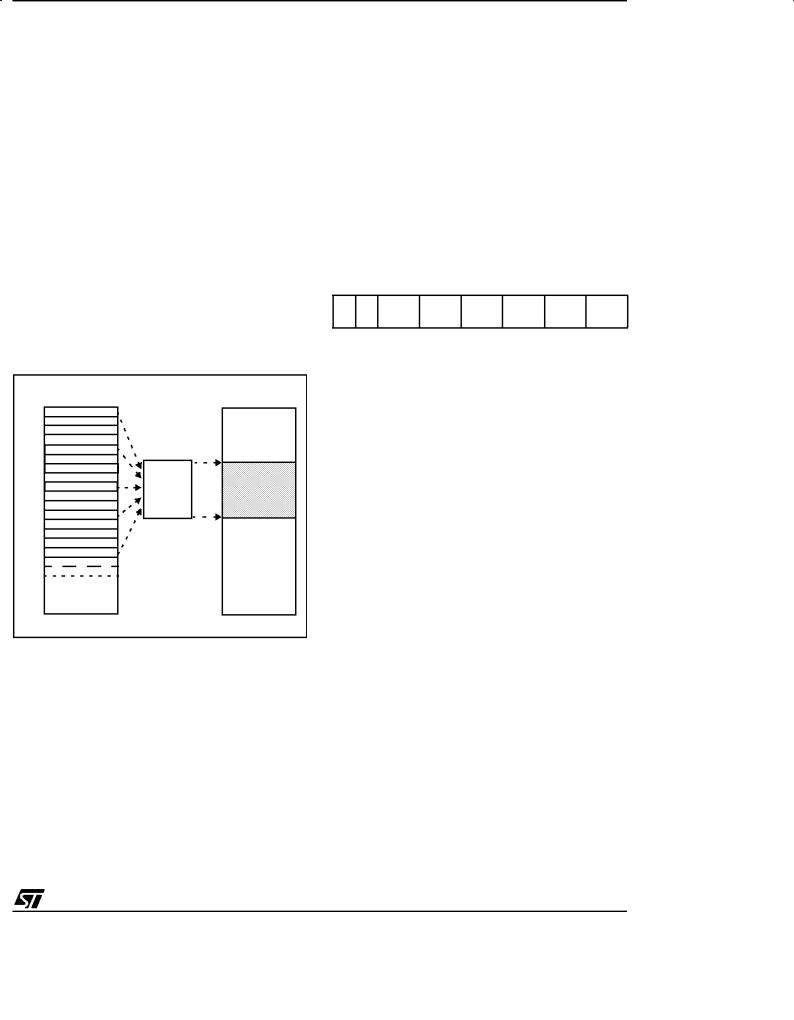
MEMORY MAP (Cont'd)
3.1.6 Data ROM Window
The Data read-only memory window is located from address 0040h to address 007Fh in Data space. It allows direct reading of 64 consecutive bytes located anywhere in program memory, between address 0000h and 0FFFh.
There are 64 blocks of 64 bytes in a 4K device:
±Block 0 is related to the address range 0000h to 003Fh.
±Block 1 is related to the address range 0040h to 007Fh.
and so on...
All the program memory can therefore be used to store either instructions or read-only data. The Data ROM window can be moved in steps of 64 bytes along the program memory by writing the appropriate code in the Data ROM Window Register (DRWR).
Figure 5. Data ROM Window
PROGRAM |
000h DATA SPACE |
0000h SPACE |
64-BYTE |
040h |
DATA ROM |
|
||
ROM |
07Fh |
WINDOW |
|
|
0FFFh |
0FFh |
ST6208C/ST6209C/ST6210C/ST6220C
3.1.6.1 Data ROM Window Register (DRWR)
The DRWR can be addressed like any RAM location in the Data Space.
This register is used to select the 64-byte block of program memory to be read in the Data ROM window (from address 40h to address 7Fh in Data space). The DRWR register is not cleared on reset, therefore it must be written to before accessing the Data read-only memory window area for the first time.
Address: 0C9h Ð Write Only
Reset Value = xxh (undefined)
7 |
0 |
-- DRWR5 DRWR4 DRWR3 DRWR2 DRWR1 DRWR0
Bits 6, 7 = Not used.
Bit 5:0 = DRWR[5:0] Data read-only memory Window Register Bits. These are the Data read-only memory Window bits that correspond to the upper bits of the data read-only memory space.
Caution: This register is undefined on reset, it is write-only, therefore do not read it nor access it using single-bit instructions (SET, RES...).
13/105
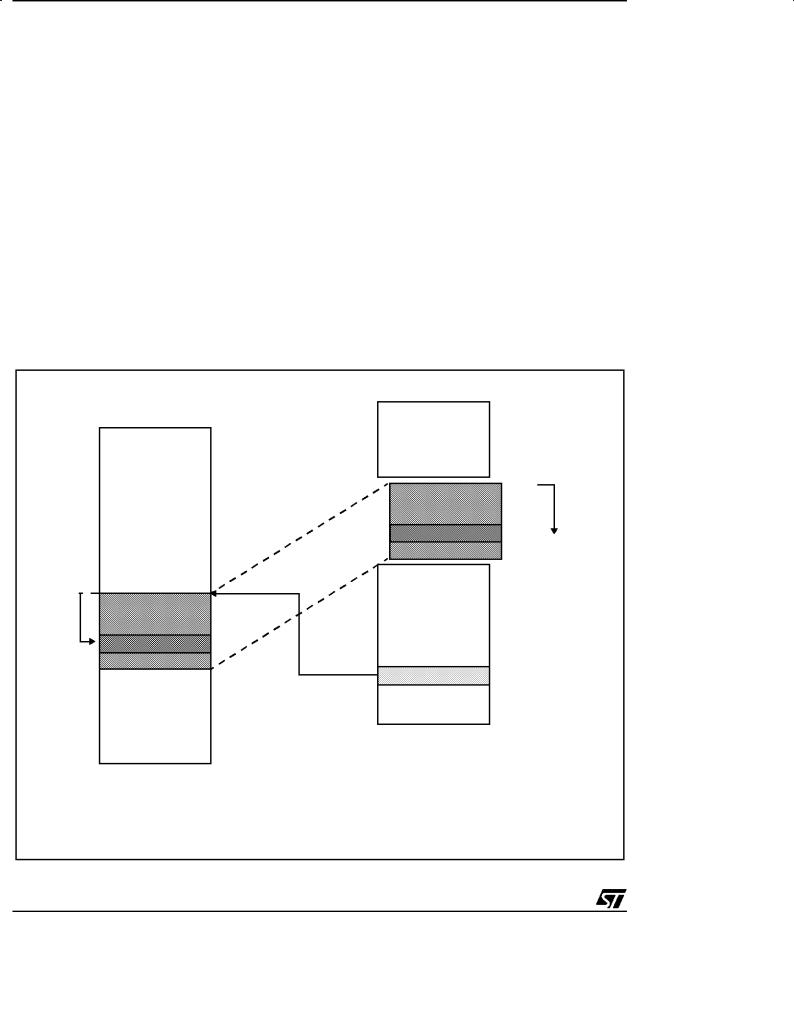
ST6208C/ST6209C/ST6210C/ST6220C
MEMORY MAP (Cont'd)
3.1.6.2 Data ROM Window memory addressing
In cases where some data (look-up tables for example) are stored in program memory, reading these data requires the use of the Data ROM window mechanism. To do this:
1. The DRWR register has to be loaded with the 64-byte block number where the data are located (in program memory). This number also gives the start address of the block.
2. Then, the offset address of the byte in the Data ROM Window (corresponding to the offset in the 64-byte block in program memory) has to be loaded in a register (A, X,...).
When the above two steps are completed, the data can be read.
To understand how to determine the DRWR and the content of the register, please refer to the example shown in Figure 6. In any case the calcula-
Figure 6. Data ROM Window Memory Addressing
tion is automatically handled by the ST6 development tools.
Please refer to the user manual of the correspoding tool.
3.1.6.3 Recommendations
Care is required when handling the DRWR register as it is write only. For this reason, the DRWR contents should not be changed while executing an interrupt service routine, as the service routine cannot save and then restore the register's previous contents. If it is impossible to avoid writing to the DRWR during the interrupt service routine, an image of the register must be saved in a RAM location, and each time the program writes to the DRWR, it must also write to the image register. The image register must be written first so that, if an interrupt occurs between the two instructions, the DRWR is not affected.
|
DATA SPACE |
|
|
PROGRAM SPACE |
000h |
|
|
|
0000h |
|
|
|
|
040h |
|
|
OFFSET |
|
DATA |
21h |
|
061h |
|
|
|
07Fh |
0400h |
|
|
OFFSET |
64 bytes |
|
|
|
|
0421h |
DATA |
|
|
|
|
|
10h |
DRWR |
|
|
0FFh |
07FFh
DATA address in Program memory : 421h
DRWR content : 421h / 3Fh (64) = 10H data is located in 64-bytes window number 10h 64-byte window start address : 10h x 3Fh = 400h
Register (A, X,...)content : Offset = (421h - 400h) + 40h ( Data ROM Window start address in data space) = 61h
14/105

3.2 PROGRAMMING MODES
3.2.1 Program Memory
EPROM/OTP programming mode is set by a +12.5V voltage applied to the TEST/VPP pin. The programming flow of the ST62T08C,T09C,T10C, T20C and E20C is described in the User Manual of the EPROM Programming Board.
Table 3. ST6208C/09C Program Memory Map
Device Address |
Description |
0000h-0B9Fh |
Reserved |
0BA0h-0F9Fh |
User ROM |
0FA0h-0FEFh |
Reserved |
0FF0h-0FF7h |
Interrupt Vectors |
0FF8h-0FFBh |
Reserved |
0FFCh-0FFDh |
NMI Interrupt Vector |
0FFEh-0FFFh |
Reset Vector |
Table 4. ST6210C Program Memory Map
Device Address |
Description |
0000h-087Fh |
Reserved |
0880h-0F9Fh |
User ROM |
0FA0h-0FEFh |
Reserved |
0FF0h-0FF7h |
Interrupt Vectors |
0FF8h-0FFBh |
Reserved |
0FFCh-0FFDh |
NMI Interrupt Vector |
0FFEh-0FFFh |
Reset Vector |
Table 5. ST6220C Program Memory Map
Device Address |
Description |
0000h-007Fh |
Reserved |
0080h-0F9Fh |
User ROM |
0FA0h-0FEFh |
Reserved |
0FF0h-0FF7h |
Interrupt Vectors |
0FF8h-0FFBh |
Reserved |
0FFCh-0FFDh |
NMI Interrupt Vector |
0FFEh-0FFFh |
Reset Vector |
Note: OTP/EPROM devices can be programmed with the development tools available from
ST6208C/ST6209C/ST6210C/ST6220C
STMicroelectronics (please refer to Section 13 on page 100).
3.2.2 EPROM Erasing
The EPROM devices can be erased by exposure to Ultra Violet light. The characteristics of the MCU are such that erasure begins when the memory is exposed to light with a wave lengths shorter than approximately 4000Å. It should be noted that sunlight and some types of fluorescent lamps have wavelengths in the range 3000-4000Å.
It is thus recommended that the window of the MCU packages be covered by an opaque label to prevent unintentional erasure problems when testing the application in such an environment.
The recommended erasure procedure is exposure to short wave ultraviolet light which have a wavelength 2537Å. The integrated dose (i.e. U.V. intensity x exposure time) for erasure should be a minimum of 30W-sec/cm2. The erasure time with this dosage is approximately 30 to 40 minutes using an ultraviolet lamp with 12000μW/cm2 power rating. The EPROM device should be placed within 2.5cm (1inch) of the lamp tubes during erasure.
15/105
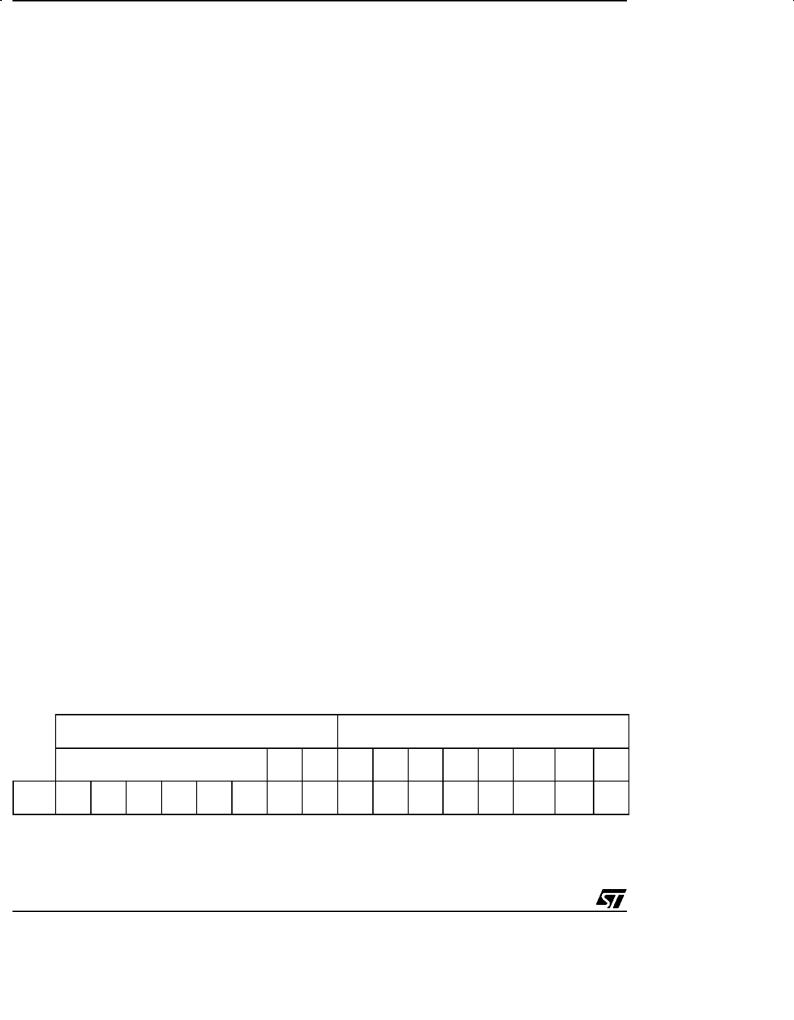
ST6208C/ST6209C/ST6210C/ST6220C
3.3 OPTION BYTES
Each device is available for production in user programmable versions (OTP) as well as in factory coded versions (ROM). OTP devices are shipped to customers with a default content (00h), while ROM factory coded parts contain the code supplied by the customer. This implies that OTP devices have to be configured by the customer using the Option Bytes while the ROM devices are facto- ry-configured.
The two option bytes allow the hardware configuration of the microcontroller to be selected.
The option bytes have no address in the memory map and can be accessed only in programming mode (for example using a standard ST6 programming tool).
In masked ROM devices, the option bytes are fixed in hardware by the ROM code (see Section 12.6.2 ºROM VERSIONº on page 98).
The option bytes can be only programmed once. It is not possible to change the selected options after they have been programmed.
MSB OPTION BYTE
Bit 15:10 = Reserved, must be always cleared.
Bit 9 = EXTCNTL External STOP MODE control.
0:EXTCNTL mode not available. STOP mode is not available with the watchdog active.
1:EXTCNTL mode available. STOP mode is avail-
able with the watchdog active by setting NMI pin to one.
Bit 8 = LVD Low Voltage Detector on/off.
This option bit enable or disable the Low Voltage Detector (LVD) feature.
0:Low Voltage Detector disabled
1:Low Voltage Detector enabled
LSB OPTION BYTE
Bit 7 = PROTECT Readout Protection.
This option bit enables or disables external access to the internal program memory.
0:Program memory not read-out protected
1:Program memory read-out protected
Bit 6 = OSC Oscillator selection.
This option bit selects the main oscillator type.
0:Quartz crystal, ceramic resonator or external clock
1:RC network
Bit 5 = Reserved, must be always cleared.
Bit 4 = Reserved, must be always set.
Bit 3 = NMI PULL NMI Pull-Up on/off.
This option bit enables or disables the internal pullup on the NMI pin.
0:Pull-up disabled
1:Pull-up enabled
Bit 2 = TIM PULL TIMER Pull-Up on/off.
This option bit enables or disables the internal pullup on the TIMER pin.
0:Pull-up disabled
1:Pull-up enabled
Bit 1 = WDACT Hardware or software watchdog.
This option bit selects the watchdog type.
0:Software (watchdog to be enabled by software)
1:Hardware (watchdog always enabled)
Bit 0 = OSGEN Oscillator Safeguard on/off.
This option bit enables or disables the oscillator Safeguard (OSG) feature.
0:Oscillator Safeguard disabled
1:Oscillator Safeguard enabled
|
|
|
MSB OPTION BYTE |
|
|
|
|
LSB OPTION BYTE |
|
|
|||||||
|
15 |
|
|
|
|
|
|
8 |
7 |
|
|
|
|
|
|
0 |
|
|
|
|
Reserved |
|
|
EXT |
LVD |
PRO- |
OSC |
Res. |
Res. |
NMI |
TIM |
WD |
OSG |
||
|
|
|
|
|
|
|
CTL |
|
TECT |
|
|
|
PULL |
PULL |
ACT |
EN |
|
Default |
X |
X |
X |
X |
X |
X |
X |
X |
X |
X |
X |
X |
X |
X |
X |
X |
|
Value |
|||||||||||||||||
|
|
|
|
|
|
|
|
|
|
|
|
|
|
|
|
||
16/105
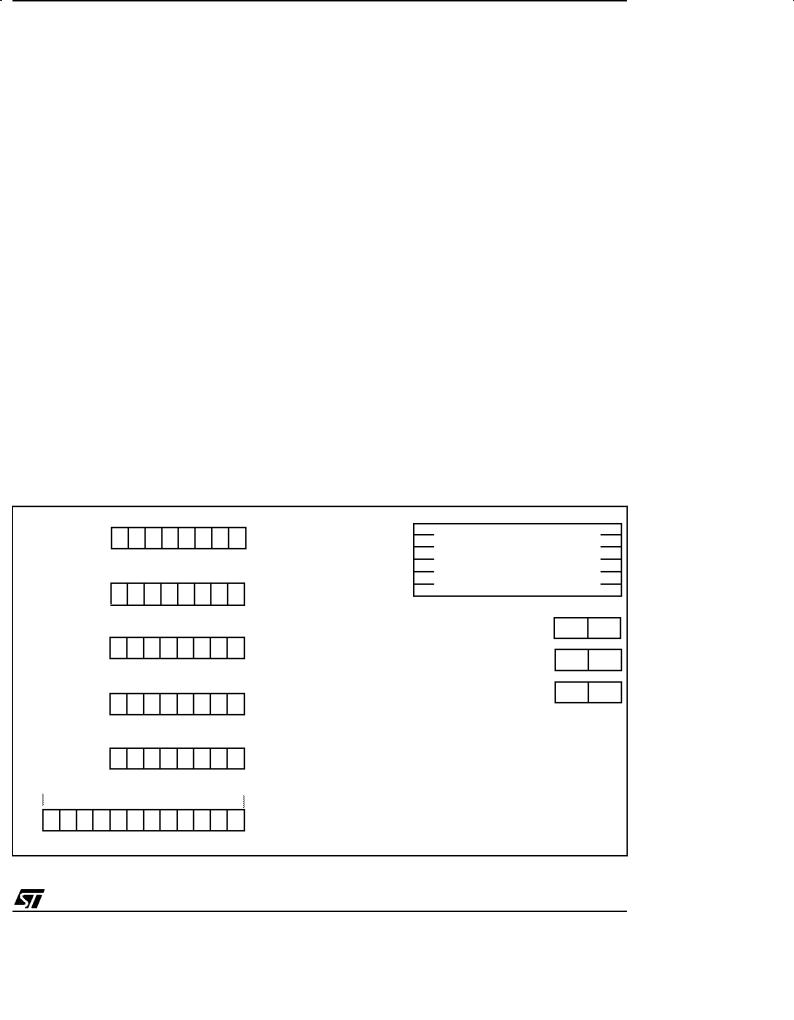
ST6208C/ST6209C/ST6210C/ST6220C
4 CENTRAL PROCESSING UNIT
4.1 INTRODUCTION
The CPU Core of ST6 devices is independent of the I/O or Memory configuration. As such, it may be thought of as an independent central processor communicating with on-chip I/O, Memory and Peripherals via internal address, data, and control buses.
4.2 MAIN FEATURES
■40 basic instructions
■9 main addressing modes
■Two 8-bit index registers
■Two 8-bit short direct registers
■Low power modes
■Maskable hardware interrupts
■6-level hardware stack
4.3 CPU REGISTERS
The ST6 Family CPU corefeatures six registers and three pairs of flags available to the programmer. These are described in the following paragraphs.
Accumulator (A). The accumulator is an 8-bit general purpose register used in all arithmetic calculations, logical operations, and data manipula-
Figure 7. CPU Registers
tions. The accumulator can be addressed in Data Space as a RAM location at address FFh. Thus the ST6 can manipulate the accumulator just like any other register in Data Space.
Index Registers (X, Y). These two registers are used in Indirect addressing mode as pointers to memory locations in Data Space. They can also be accessed in Direct, Short Direct, or Bit Direct addressing modes. They are mapped in Data Space at addresses 80h (X) and 81h (Y) and can be accessed like any other memory location.
Short Direct Registers (V, W). These two registers are used in Short Direct addressing mode. This means that the data stored in V or W can be accessed with a one-byte instruction (four CPU cycles). V and W can also be accessed using Direct and Bit Direct addressing modes. They are mapped in Data Space at addresses 82h (V) and 83h (W) and can be accessed like any other memory location.
Note: The X and Y registers can also be used as Short Direct registers in the same way as V and W.
Program Counter (PC). The program counter is a 12-bit register which contains the address of the next instruction to be executed by the core. This ROM location may be an opcode, an operand, or the address of an operand.
7 |
0 |
|
|
|
|
ACCUMULATOR |
|
|
|
RESET VALUE = xxh |
|
SIX LEVEL |
|
|
7 |
0 |
STACK |
|
|
|
|
|
||
|
X INDEX REGISTER |
|
|
|
RESET VALUE = xxh |
|
|
|
|
7 |
0 |
NORMAL FLAGS |
CN |
ZN |
|
Y INDEX REGISTER |
|
CI |
ZI |
RESET VALUE = xxh |
|
INTERRUPT FLAGS |
||
|
|
|
|
|
7 |
0 |
NMI FLAGS |
CNMI ZNMI |
|
|
V SHORT INDIRECT |
|||
|
REGISTER |
|
|
|
RESET VALUE = xxh |
|
|
|
|
7 |
0 |
|
|
|
|
W SHORT INDIRECT |
|
|
|
RESET VALUE = xxh |
REGISTER |
|
|
|
|
|
|
|
|
11 |
0 |
|
|
|
|
PROGRAM COUNTER |
|
|
|
RESET VALUE = RESET VECTOR @ 0FFEh-0FFFh |
x = Undefined value |
|||
17/105
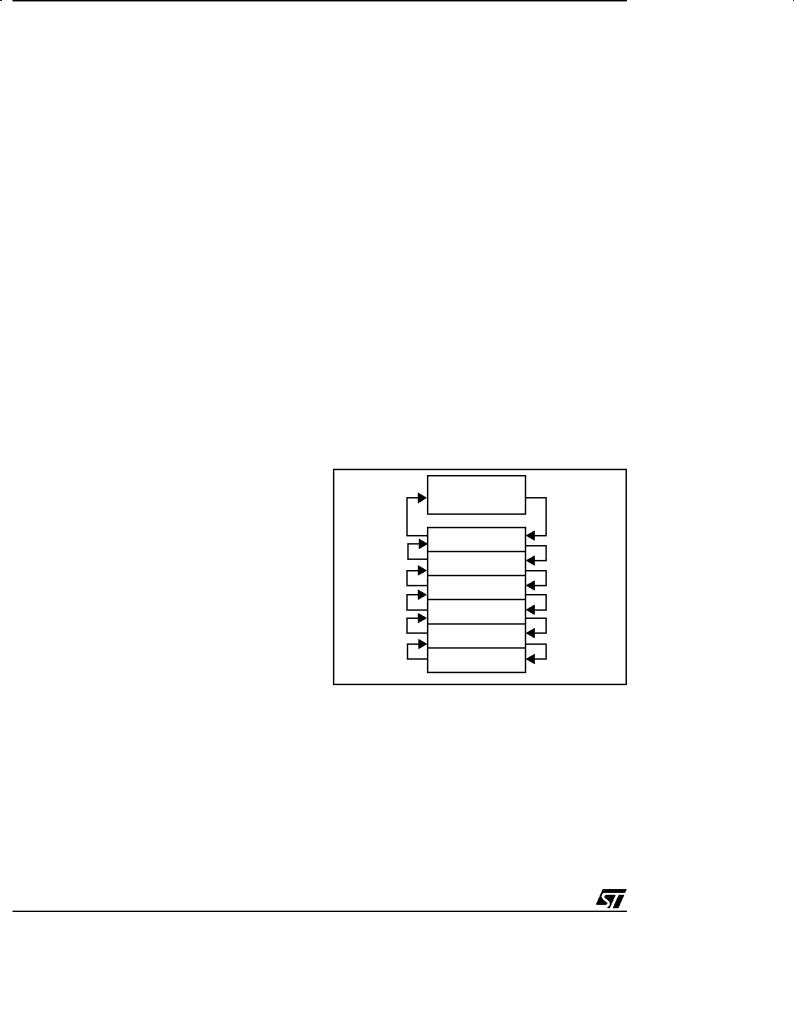
ST6208C/ST6209C/ST6210C/ST6220C
CPU REGISTERS (Cont'd)
The 12-bit length allows the direct addressing of 4096 bytes in Program Space.
However, if the program space contains more than 4096 bytes, the additional memory in program space can be addressed by using the Program ROM Page register.
The PC value is incremented after reading the address of the current instruction. To execute relative jumps, the PC and the offset are shifted through the ALU, where they are added; the result is then shifted back into the PC. The program counter can be changed in the following ways:
± JP (Jump) instruction |
PC = Jump address |
± CALL instruction |
PC = Call address |
± Relative Branch InstructionPC = PC +/- offset
± Interrupt |
PC = Interrupt vector |
± Reset |
PC = Reset vector |
± RET & RETI instructions |
PC = Pop (stack) |
± Normal instruction |
PC = PC + 1 |
Flags (C, Z). The ST6 CPU includes three pairs of flags (Carry and Zero), each pair being associated with one of the three normal modes of operation: Normal mode, Interrupt mode and Non Maskable Interrupt mode. Each pair consists of a CARRY flag and a ZERO flag. One pair (CN, ZN) is used during Normal operation, another pair is used during Interrupt mode (CI, ZI), and a third pair is used in the Non Maskable Interrupt mode (CNMI, ZNMI).
The ST6 CPU uses the pair of flags associated with the current mode: as soon as an interrupt (or a Non Maskable Interrupt) is generated, the ST6 CPU uses the Interrupt flags (or the NMI flags) instead of the Normal flags. When the RETI instruction is executed, the previously used set of flags is restored. It should be noted that each flag set can only be addressed in its own context (Non Maskable Interrupt, Normal Interrupt or Main routine). The flags are not cleared during context switching and thus retain their status.
C : Carry flag.
This bit is set when a carry or a borrow occurs during arithmetic operations; otherwise it is cleared. The Carry flag is also set to the value of the bit tested in a bit test instruction; it also participates in the rotate left instruction.
0:No carry has occured
1:A carry has occured
Z : Zero flag
This flag is set if the result of the last arithmetic or logical operation was equal to zero; otherwise it is cleared.
0:The result of the last operation is different from zero
1:The result of the last operation is zero
Switching between the three sets of flags is performed automatically when an NMI, an interrupt or a RETI instruction occurs. As NMI mode is automatically selected after the reset of the MCU, the ST6 core uses the NMI flags first.
Stack. The ST6 CPU includes a true LIFO (Last In First Out) hardware stack which eliminates the need for a stack pointer. The stack consists of six separate 12-bit RAM locations that do not belong to the data space RAM area. When a subroutine call (or interrupt request) occurs, the contents of each level are shifted into the next level down, while the content of the PC is shifted into the first level (the original contents of the sixth stack level are lost). When a subroutine or interrupt return occurs (RET or RETI instructions), the first level register is shifted back into the PC and the value of each level is popped back into the previous level.
Figure 8. Stack manipulation
PROGRAM
COUNTER
ON RETURN |
LEVEL 1 |
ON |
|
FROM |
INTERRUPT, |
||
|
|||
INTERRUP T, |
LEVEL 2 |
OR |
|
OR |
SUBROUTINE |
||
SUBROUTINE |
LEVEL 3 |
CALL |
|
|
|
||
|
LEVEL 4 |
|
|
|
LEVEL 5 |
|
|
|
LEVEL 6 |
|
Since the accumulator, in common with all other data space registers, is not stored in this stack, management of these registers should be performed within the subroutine.
Caution: The stack will remain in its ªdeepestº position if more than 6 nested calls or interrupts are executed, and consequently the last return address will be lost.
It will also remain in its highest position if the stack is empty and a RET or RETI is executed. In this case the next instruction will be executed.
18/105
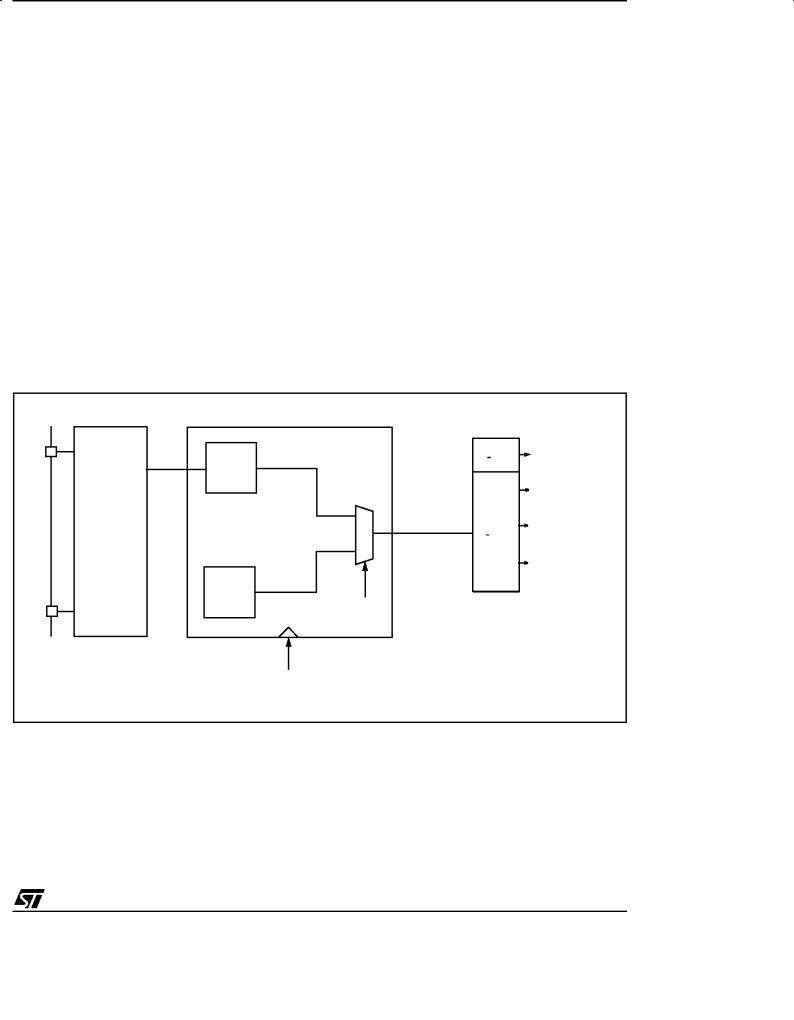
5 CLOCKS, SUPPLY AND RESET
5.1 CLOCK SYSTEM
The main oscillator of the MCU can be driven by any of these clock sources:
±external clock signal
±external AT-cut parallel-resonant crystal
±external ceramic resonator
±external RC network (RNET).
In addition, an on-chip Low Frequency Auxiliary Oscillator (LFAO) is available as a back-up clock system or to reduce power consumption.
An optional Oscillator Safeguard (OSG) filters spikes from the oscillator lines, and switches to the LFAO backup oscillator in the event of main oscillator failure. It also automatically limits the internal clock frequency (fINT) as a function of VDD, in order to guarantee correct operation. These functions are illustrated in Figure 10, and Figure 11.
Figure 9. Clock Circuit Block Diagram
ST6208C/ST6209C/ST6210C/ST6220C
Table 6 illustrates various possible oscillator configurations using an external crystal or ceramic resonator, an external clock input, an external resistor (RNET), or the lowest cost solution using only the LFAO.
For more details on configuring the clock options, refer to the Option Bytes section of this document.
The internal MCU clock frequency (fINT) is divided by 12 to drive the Timer, the Watchdog timer and the A/D converter (if available), and by 13 to drive the CPU core, as shown in Figure 9.
With an 8 MHz oscillator, the fastest CPU cycle is therefore 1.625μs.
A CPU cycle is the smallest unit of time needed to execute any operation (for instance, to increment the Program Counter). An instruction may require two, four, or five CPU cycles for execution.
|
OSCILLATOR SAFEGU ARD (OSG) |
|
|
fOSC |
OSG |
: 13 |
CORE |
|
|
||
|
filtering |
|
|
|
|
|
8-BIT TIMER |
|
0 |
fINT |
|
MAIN |
|
WATCHDOG |
OSCILLATOR |
: 12 |
|
1 |
||
|
||
|
* |
|
|
ADC |
|
|
LFAO |
|
|
OSCOFF BIT |
|
|
(ADCR REGISTER )* |
|
|
OSG ENABLE OPTION BIT (See OPTION BYTE SECTION) |
|
|
* Depending on device. See device summary on page 1. |
19/105

ST6208C/ST6209C/ST6210C/ST6220C
CLOCK SYSTEM (Cont'd)
5.1.1 Main Oscillator
The oscillator configuration is specified by selecting the appropriate option in the option bytes (refer to the Option Bytes section of this document). When the CRYSTAL/RESONATOR option is selected, it must be used with a quartz crystal, a ceramic resonator or an external signal provided on the OSCin pin. When the RC NETWORK option is selected, the system clock is generated by an external resistor (the capacitor is implemented internally).
The main oscillator can be turned off (when the OSG ENABLED option is selected) by setting the OSCOFF bit of the ADC Control Register (not available on some devices). This will automatically start the Low Frequency Auxiliary Oscillator (LFAO).
The main oscillator can be turned off by resetting the OSCOFF bit of the A/D Converter Control Register or by resetting the MCU. When the main oscillator starts there is a delay made up of the oscillator start-up delay period plus the duration of the software instruction at a clock frequency fLFAO.
Caution: It should be noted that when the RC network option is selected, the accuracy of the frequency is about 20% so it may not be suitable for some applications (For more details, please refer to the Electrical Characteristics Section).
Table 6. Oscillator Configurations
Hardware Configur ation
1) |
|
|
|
Option |
External Clock |
||
|
|||
Crystal/Resonator |
|
ST6 |
|
OSCin |
OSCout |
||
|
|||
|
|
NC |
|
|
EXTERNAL |
||
|
CLOCK |
|
|
1) |
Crystal/Resonator Clock 2) |
||
Option |
|||
|
ST6 |
||
|
|
||
Crystal/Resonator |
OSCin |
OSCout |
|
CAPACITORS 3) |
|||
|
CL1 |
CL2 |
|
|
|
LOAD |
|
|
RC Network |
||
1) |
|
ST6 |
|
Option |
|
||
OSCin |
OSCout |
||
Network |
|||
NC |
RNET |
||
|
|
||
RC |
|
|
|
1) |
LFAO |
||
Option |
|||
|
ST6 |
||
Enabled |
OSCin |
NC |
|
|
OSCout |
||
OSG |
|
|
|
Notes:
1. To select the options shown in column 1 of the above table, refer to the Option Byte section.
2.This schematic are given for guidance only and are subject to the schematics given by the crystal or ceramic resonator manufacturer.
3. For more details, please refer to the Electrical Characteristics Section.
20/105
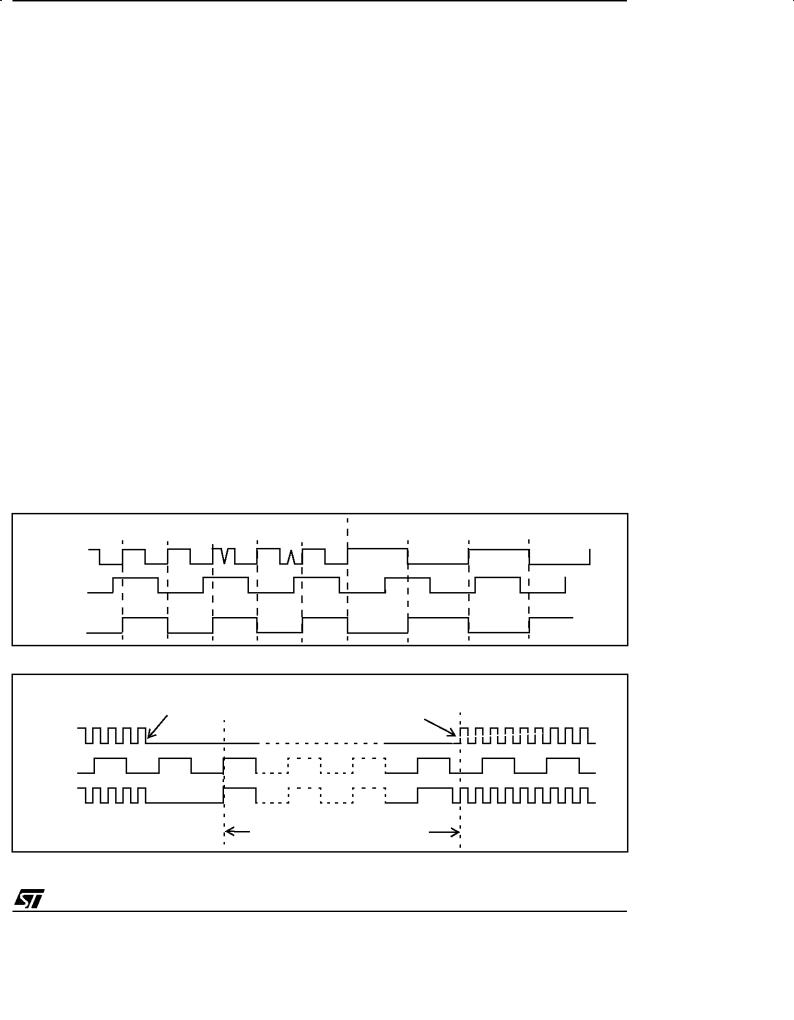
CLOCK SYSTEM (Cont'd)
5.1.2 Oscillator Safeguard (OSG)
The Oscillator Safeguard (OSG) feature is a means of dramatically improving the operational integrity of the MCU. It is available when the OSG ENABLED option is selected in the option byte (refer to the Option Bytes section of this document).
The OSG acts as a filter whose cross-over frequency is device dependent and provides three basic functions:
±Filtering spikes on the oscillator lines which would result in driving the CPU at excessive frequencies
±Management of the Low Frequency Auxiliary Oscillator (LFAO), (useable as low cost internal
clock source, backup clock in case of main oscillator failure or for low power consumption)
± Automatically limiting the fINT clock frequency as a function of supply voltage, to ensure correct operation even if the power supply drops.
5.1.2.1 Spike Filtering
Spikes on the oscillator lines result in an effectively increased internal clock frequency. In the absence of an OSG circuit, this may lead to an over frequency for a given power supply voltage. The OSG filters out such spikes (as illustrated in Figure 10). In all cases, when the OSG is active, the max-
Figure 10. OSG Filtering Function
fOSC>fOSG
fOSC
fOSG
fINT
Figure 11. LFAO Oscillator Function
MAIN OSCILLATOR
STOPS
fOSC
fLFAO
fINT
ST6208C/ST6209C/ST6210C/ST6220C
imum internal clock frequency, fINT, is limited to fOSG, which is supply voltage dependent.
5.1.2.2 Management of Supply Voltage Variations
Over-frequency, at a given power supply level, is seen by the OSG as spikes; it therefore filters out some cycles in order that the internal clock frequency of the device is kept within the range the particular device can stand (depending on VDD), and below fOSG: the maximum authorised frequency with OSG enabled.
5.1.2.3 LFAO Management
When the OSG is enabled, the Low Frequency Auxiliary Oscillator can be used (see Section 5.1.3).
Note: The OSG should be used wherever possible as it provides maximum security for the application. It should be noted however, that it can increase power consumption and reduce the maximum operating frequency to fOSG (see Electrical Characteristics section).
Caution: Care has to be taken when using the OSG, as the internal frequency is defined between a minimum and a maximum value and may vary depending on both VDD and temperature. For precise timing measurements, it is not recommended to use the OSG.
fOSC<fOSG
MAIN OSCILLATOR
RESTARTS
INTERNAL CLOCK DRIVEN BY LFAO
21/105
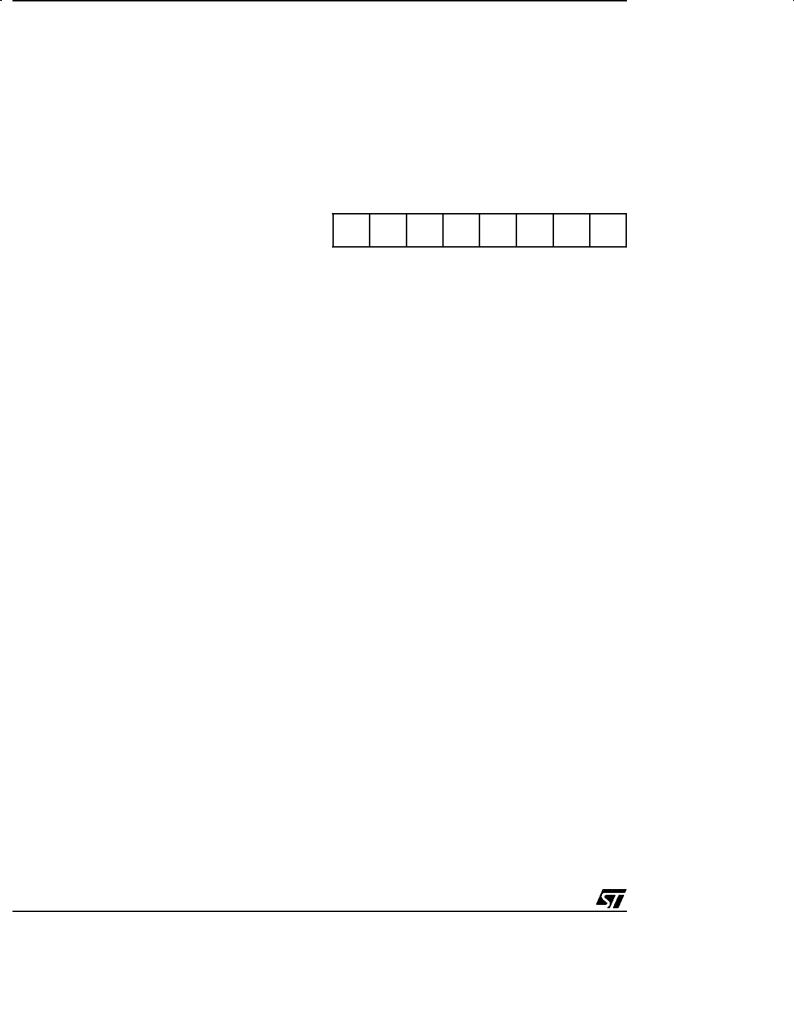
ST6208C/ST6209C/ST6210C/ST6220C
CLOCK SYSTEM (Cont'd)
5.1.3Low Frequency Auxiliary Oscillator The Low Frequency Auxiliary Oscillator is auto-
(LFAO)
The Low Frequency Auxiliary Oscillator has three main purposes. Firstly, it can be used to reduce power consumption in non timing critical routines. Secondly, it offers a fully integrated system clock, without any external components. Lastly, it acts as a backup oscillator in case of main oscillator failure.
This oscillator is available when the OSG ENABLED option is selected in the option byte (refer to the Option Bytes section of this document). In this case, it automatically starts one of its periods after the first missing edge of the main oscillator, whatever the reason for the failure (main oscillator defective, no clock circuitry provided, main oscillator switched off...). See Figure 11.
User code, normal interrupts, WAIT and STOP instructions, are processed as normal, at the reduced fLFAO frequency. The A/D converter accuracy is decreased, since the internal frequency is below 1.2 MHz.
At power on, until the main oscillator starts, the 2048 clock cycle counter is driven by the LFAO. If the main oscillator starts before the 2048 cycle delay has elapsed, it takes over.
matically switched off as soon as the main oscillator starts.
5.1.4 Register Description
ADC CONTROL REGISTER (ADCR)
Address: 0D1h Ð Read/Write Reset value: 0100 0000 (40h)
7 |
|
|
|
|
|
|
0 |
ADCR |
ADCR |
ADCR |
ADCR |
ADCR |
OSC |
ADCR |
ADCR |
7 |
6 |
5 |
4 |
3 |
OFF |
1 |
0 |
Bit 7:3, 1:0 = ADCR[7:3], ADCR[1:0] ADC Control Register.
These bits are used to control the A/D converter (if available on the device) otherwise they are not used.
Bit 2 = OSCOFF Main Oscillator Off.
0:Main oscillator enabled
1:Main oscillator disabled
Note: The OSG must be enabled using the OSGEN option in the Option Byte, otherwise the OSCOFF setting has no effect.
22/105

5.2 LOW VOLTAGE DETECTOR (LVD)
The on-chip Low Voltage Detector is enabled by setting a bit in the option bytes (refer to the Option Bytes section of this document).
The LVD allows the device to be used without any external RESET circuitry. In this case, the RESET pin should be left unconnected.
If the LVD is not used, an external circuit is mandatory to ensure correct Power On Reset operation, see figure in the Reset section. For more details, please refer to the application note AN669.
The LVD generates a static Reset when the supply voltage is below a reference value. This means that it secures the power-up as well as the powerdown keeping the ST6 in reset.
The VIT- reference value for a voltage drop is lower than the VIT+ reference value for power-on in order to avoid a parasitic reset when the MCU starts running and sinks current on the supply (hysteresis).
Figure 12. Low Voltage Detector Reset
VDD
VIT+
VIT-
ST6208C/ST6209C/ST6210C/ST6220C
The LVD Reset circuitry generates a reset when VDD is below:
±VIT+ when VDD is rising
±VIT- when VDD is falling
The LVD function is illustrated in Figure 12.
If the LVD is enabled, the MCU can be in only one of two states:
±Over the input threshold voltage, it is running under full software control
±Below the input threshold voltage, it is in static safe reset
In these conditions, secure operation is guaranteed without the need for external reset hardware.
During a Low Voltage Detector Reset, the RESET pin is held low, thus permitting the MCU to reset other devices.
Vhyst
RESET
23/105
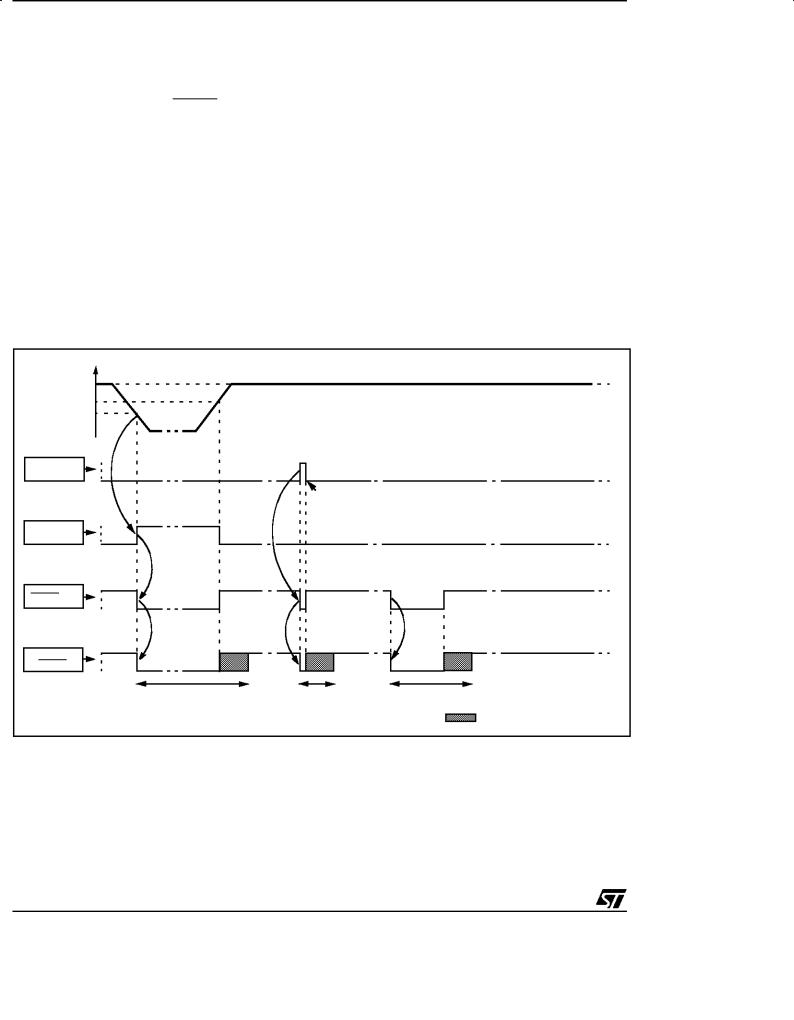
ST6208C/ST6209C/ST6210C/ST6220C
5.3 RESET
5.3.1 Introduction
The MCU can be reset in three ways:
■A low pulse input on the RESET pin
■Internal Watchdog reset
■Internal Low Voltage Detector (LVD) reset
5.3.2 RESET sequence
The basic RESET sequence consists of 3 main phases:
■Internal (watchdog or LVD) or external Reset event
■A delay of 2048 clock (fINT) cycles
■RESET vector fetch
The 2048 clock cycle delay allows the oscillator to stabilise and ensures that recovery has taken place from the Reset state.
Figure 13. RESET Sequence
VDD
The RESET vector fetch phase duration is 2 clock cycles.
When a reset occurs:
±The stack is cleared
±The PC is loaded with the address of the Reset vector. It is located in program ROM starting at address 0FFEh.
A jump to the beginning of the user program must be coded at this address.
± The interrupt flag is automatically set, so that the CPU is in Non Maskable Interrupt mode. This prevents the initialization routine from being interrupted. The initialization routine should therefore be terminated by a RETI instruction, in order to go back to normal mode.
VIT+
VIT-
WATCHDOG
RESET
WATCHDOG UNDERFLOW
LVD
RESET |
|
|
|
|
|
RESET PIN |
|
|
|
|
|
INTERNAL |
RUN |
RUN |
RUN |
RUN |
|
RESET |
|||||
|
|
|
|
||
|
RESET |
|
RESET |
RESET |
|
|
|
|
|
2048 CLOCK CYCLE (fINT) DELAY |
24/105
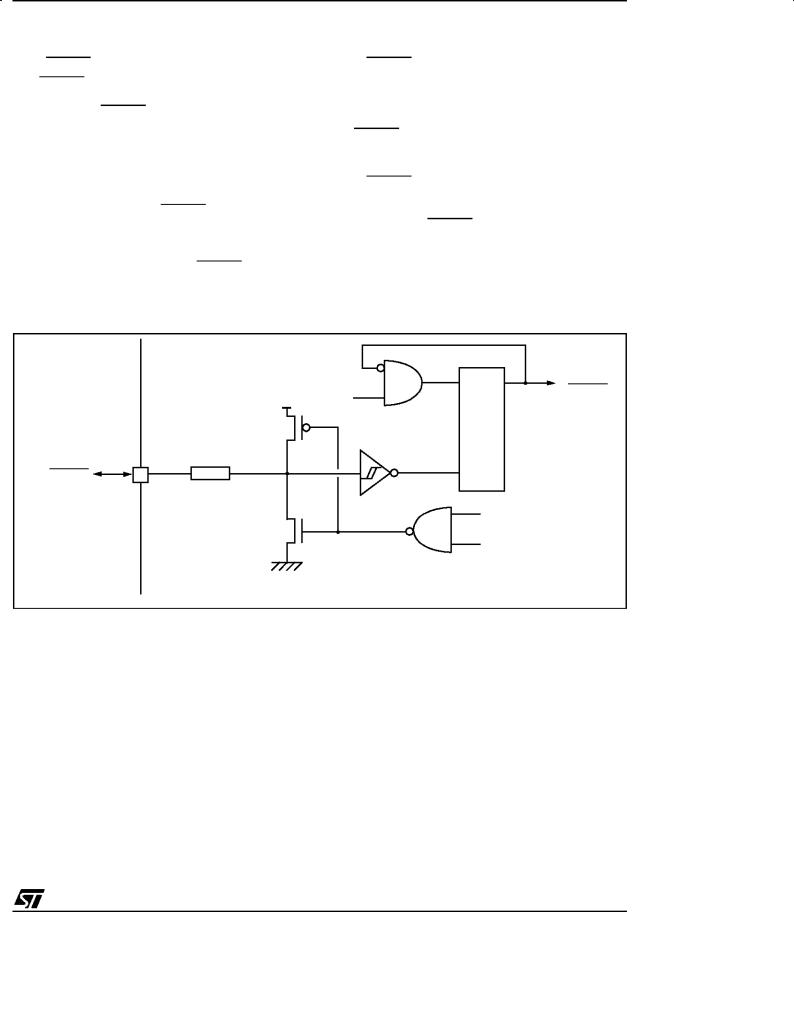
RESET (Cont'd)
5.3.3 RESET Pin
The RESET pin may be connected to a device on the application board in order to reset the MCU if required. The RESET pin may be pulled low in RUN, WAIT or STOP mode. This input can be used to reset the internal state of the MCU and ensure it starts-up correctly. The pin, which is connected to an internal pull-up, is active low and features a Schmitt trigger input. A delay (2048 clock cycles) added to the external signal ensures that even short pulses on the RESET pin are accepted as valid, provided VDD has completed its rising phase and that the oscillator is running correctly (normal RUN or WAIT modes). The MCU is kept in the Reset state as long as the RESET pin is held low.
Figure 14. Reset Block Diagram
VDD
RPU
RESET
RESD1)
1) Resistive ESD protection
ST6208C/ST6209C/ST6210C/ST6220C
If the RESET pin is grounded while the MCU is in RUN or WAIT modes, processing of the user program is stopped (RUN mode only), the I/O ports are configured as inputs with pull-up resistors and the main oscillator is restarted. When the level on the RESET pin then goes high, the initialization sequence is executed at the end of the internal delay period.
If the RESET pin is grounded while the MCU is in STOP mode, the oscillator starts up and all the I/O ports are configured as inputs with pull-up resistors. When the RESET pin level then goes high, the initialization sequence is executed at the end of the internal delay period.
A simple external RESET circuitry is shown in Figure 15. For more details, please refer to the application note AN669.
COUNTER |
cyclesclock2048 |
INTERNAL |
|
RESET |
|||
fINT |
|
||
|
|
WATCHDOG RESET
LVD RESET
25/105

ST6208C/ST6209C/ST6210C/ST6220C
RESET (Cont'd)
5.3.4 Watchdog Reset
The MCU provides a Watchdog timer function in order to be able to recover from software hangups. If the Watchdog register is not refreshed before an end-of-count condition is reached, a Watchdog reset is generated.
After a Watchdog reset, the MCU restarts in the same way as if a Reset was generated by the RESET pin.
Note: When a watchdog reset occurs, the RESET pin is tied low for very short time period, to flag the reset phase. This time is not long enough to reset external circuits.
For more details refer to the Watchdog Timer chapter.
5.3.5 LVD Reset
Two different RESET sequences caused by the internal LVD circuitry can be distinguished:
■Power-On RESET
■Voltage Drop RESET
During an LVD reset, the RESET pin is pulled low
when VDD<VIT+ (rising edge) or VDD<VIT- (falling edge).
For more details, refer to the LVD chapter.
Caution: Do not externally connect directly the RESET pin to VDD, this may cause damage to the component in case of internal RESET (Watchdog or LVD).
Figure 15. Simple external Reset Circuitry
VDD |
VDD |
|
R |
|
RESET |
|
C |
Typical: R = 10K |
ST62xx |
|
|
C = 10nF |
R > 4.7 K |
Figure 16. Reset Processing
RESET
2048 CLOCK CYCLE
DELAY
INTERNAL
RESET
NMI MASK SET
INT LATCH CLEARED
(IF PRESENT)
SELECT
NMI MODE FLAGS
PUT FFEh
ON ADDRESS BUS
YES
IS RESET STILL
PRESENT?
NO
LOAD PC
FROM RESET LOCATIONS
FFEh/FFFh
FETCH INSTR UCTION
26/105
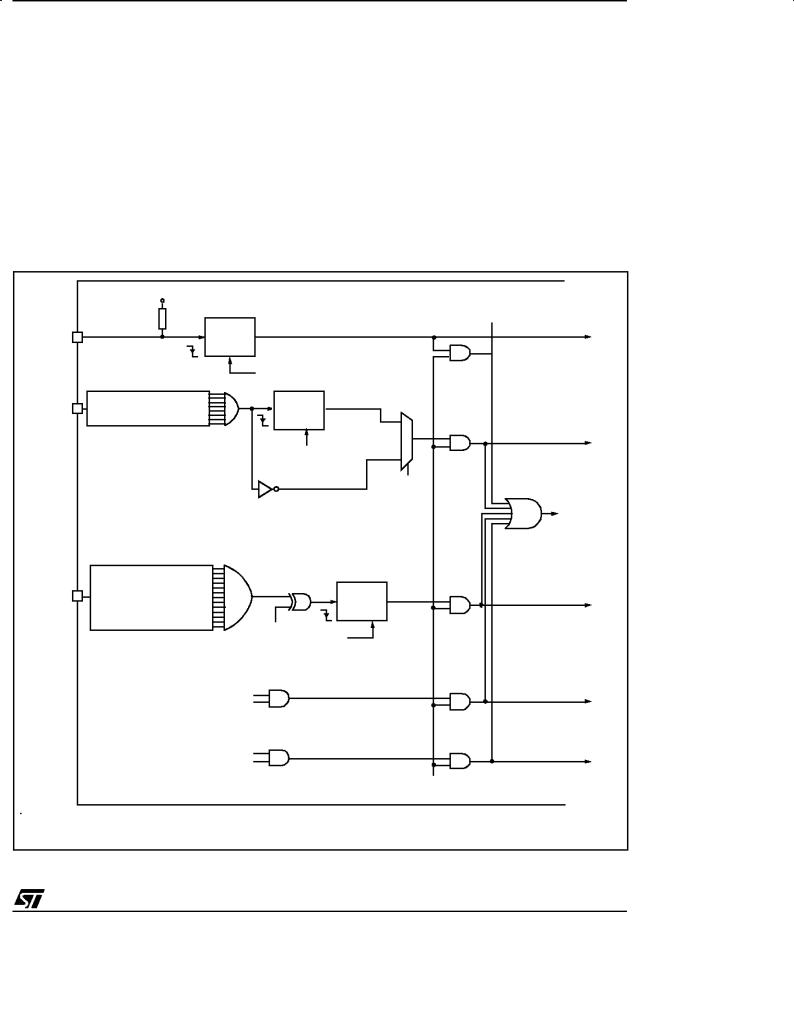
6 INTERRUPTS
The ST6 core may be interrupted by four maskable interrupt sources, in addition to a Non Maskable Interrupt (NMI) source. The interrupt processing flowchart is shown in Figure 18.
Maskable interrupts must be enabled by setting the GEN bit in the IOR register. However, even if they are disabled (GEN bit = 0), interrupt events are latched and may be processed as soon as the GEN bit is set.
Each source is associated with a specific Interrupt Vector, located in Program space (see Table 8). In the vector location, the user must write a Jump in-
Figure 17. Interrupts Block Diagram
VDD
ST6208C/ST6209C/ST6210C/ST6220C
struction to the associated interrupt service routine.
When an interrupt source generates an interrupt request, the PC register is loaded with the address of the interrupt vector, which then causes a Jump to the relevant interrupt service routine, thus servicing the interrupt.
Interrupt are triggered by events either on external pins, or from the on-chip peripherals. Several events can be ORed on the same interrupt vector. On-chip peripherals have flag registers to determine which event triggered the interrupt.
NMI
PA0...P A3
PB0...PB7
LATCH
CLEARED BY H/W
AT START OF VECTOR #0 ROUTINE
I/O PORT REGISTER |
|
|
ªINPUT WITH INTERRUPTº |
LATCH |
|
CONFIGURATION |
|
0 |
|
|
|
|
CLEARED BY H/W |
1 |
AT START OF
VECTOR #1 ROUTINE
LES BIT (IOR REGISTER)
I/O PORT REGISTER |
|
|
ªINPUT WITH INTERRUPTº |
LATCH |
|
CONFIGURATION |
|
|
|
|
|
|
|
ESB BIT |
|
(IOR REGISTER) CLEARED |
|
|
|
BY H/W AT START OF |
|
|
VECTOR #2 ROUTINE |
TIMER |
TMZ BIT |
|
ETI BIT |
|
|
|
|
|
(TSCR REGISTER) |
||
A/D CONVERTER * |
EAI BIT |
|
|
EOC BIT |
|
(ADCR REGISTER) |
GEN BIT |
|
|
|
(IOR REGISTE R) |
VECTOR #0
VECTOR #1
EXIT FROM
STOP/WAI T
VECTOR #2
VECTOR #3
VECTOR #4
* Depending on device. See device summary on page 1.
27/105

ST6208C/ST6209C/ST6210C/ST6220C
6.1 INTERRUPT RULES AND PRIORITY MANAGEMENT
■A Reset can interrupt the NMI and peripheral interrupt routines
■The Non Maskable Interrupt request has the highest priority and can interrupt any peripheral interrupt routine at any time but cannot interrupt another NMI interrupt.
■No peripheral interrupt can interrupt another. If more than one interrupt request is pending, these are processed by the processor core according to their priority level: vector #1 has the highest priority while vector #4 the lowest. The priority of each interrupt source is fixed by hardware (see Interrupt Mapping table).
6.3 NON MASKABLE INTERRUPT
This interrupt is triggered when a falling edge occurs on the NMI pin regardless of the state of the GEN bit in the IOR register. An interrupt request on NMI vector #0 is latched by a flip flop which is automatically reset by the core at the beginning of the NMI service routine.
6.4 PERIPHERAL INTERRUPTS
Different peripheral interrupt flags in the peripheral control registers are able to cause an interrupt when they are active if both:
±The GEN bit of the IOR register is set
±The corresponding enable bit is set in the peripheral control register.
6.2 INTERRUPTS AND LOW POWER MODES
All interrupts cause the processor to exit from WAIT mode. Only the external and some specific interrupts from the on-chip peripherals cause the processor to exit from STOP mode (refer to the ªExit from STOPª column in the Interrupt Mapping Table).
Peripheral interrupts are linked to vectors #3 and #4. Interrupt requests are flagged by a bit in their corresponding control register. This means that a request cannot be lost, because the flag bit must be cleared by user software.
28/105

6.5 EXTERNAL INTERRUPTS (I/O Ports)
External interrupt vectors can be loaded into the PC register if the corresponding external interrupt occurred and if the GEN bit is set. These interrupts allow the processor to exit from STOP mode.
The external interrupt polarity is selected through the IOR register.
External interrupts are linked to vectors #1 and # 2.
Interrupt requests on vector #1 can be configured either as edge or level-sensitive using the LES bit in the IOR Register.
Interrupt requests from vector #2 are always edge sensitive. The edge polarity can be configured using the ESB bit in the IOR Register.
In edge-sensitive mode, a latch is set when a edge occurs on the interrupt source line and is cleared when the associated interrupt routine is started. So, an interrupt request can be stored until completion of the currently executing interrupt routine, before being processed. If several interrupt requests occurs before completion of the current interrupt routine, only the first request is stored.
Storing of interrupt requests is not possible in level sensitive mode. To be taken into account, the low level must be present on the interrupt pin when the MCU samples the line after instruction execution.
6.5.1 Notes on using External Interrupts
ESB bit Spurious Interrupt on Vector #2
If a pin associated with interrupt vector #2 is configured as interrupt with pull-up, whenever vector #2 is configured to be rising edge sensitive (by setting the ESB bit in the IOR register), an interrupt is latched although a rising edge may not have occured on the associated pin.
ST6208C/ST6209C/ST6210C/ST6220C
This is due to the vector #2 circuitry.The workaround is to discard this first interrupt request in the routine (using a flag for example).
Masking of One Interrupt by Another on Vector #2.
When two or more port pins (associated with interrupt vector #2) are configured together as input with interrupt (falling edge sensitive), as long as one pin is stuck at '0', the other pin can never generate an interrupt even if an active edge occurs at this pin. The same thing occurs when one pin is stuck at '1' and interrupt vector #2 is configured as rising edge sensitive.
To avoid this the first pin must input a signal that goes back up to '1' right after the falling edge. Otherwise, in the interrupt routine for the first pin, deactivate the ªinput with interruptº mode using the port control registers (DDR, OR, DR). An active edge on another pin can then be latched.
I/O port Configuration Spurious Interrupt on Vector #2
If a pin associated with interrupt vector #2 is in `input with pull-up' state, a `0' level is present on the pin and the ESB bit = 0, when the I/O pin is configured as interrupt with pull-up by writing to the DDRx, ORx and DRx register bits, an interrupt is latched although a falling edge may not have occurred on the associated pin.
In the opposite case, if the pin is in interrupt with pull-up state , a 0 level is present on the pin and the ESB bit =1, when the I/O port is configured as input with pull-up by writing to the DDRx, ORx and DRx bits, an interrupt is latched although a rising edge may not have occurred on the associated pin.
29/105
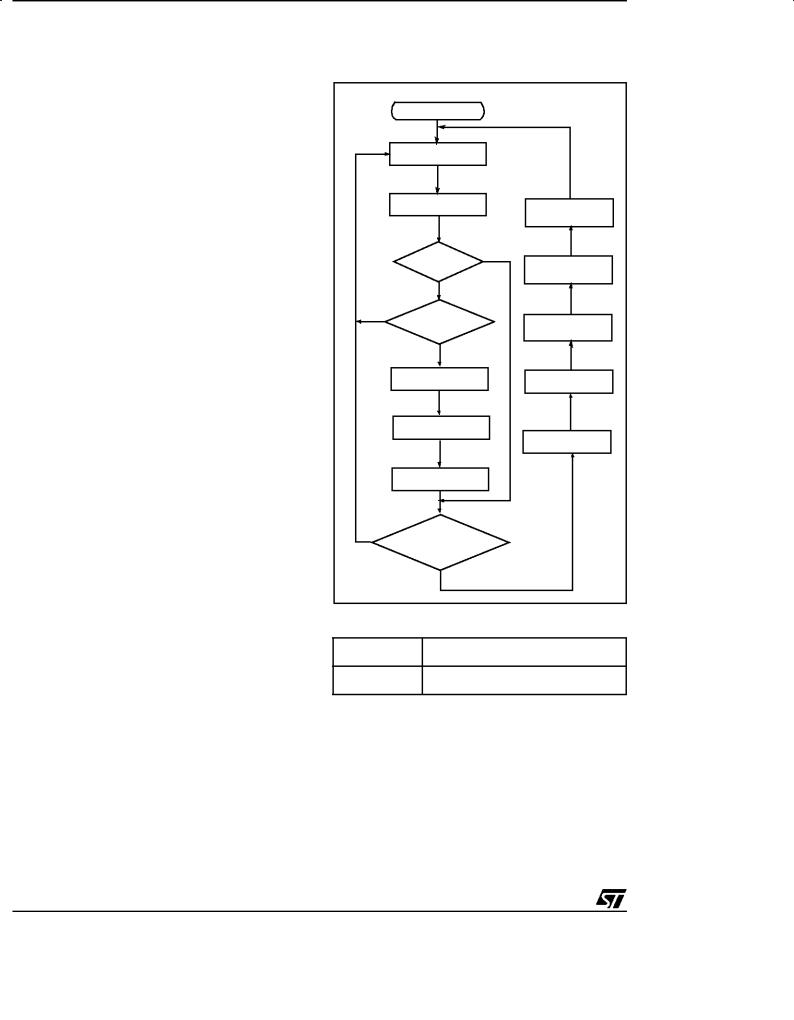
ST6208C/ST6209C/ST6210C/ST6220C
6.6 INTERRUPT HANDLING PROCEDURE
The interrupt procedure is very similar to a call procedure, in fact the user can consider the interrupt as an asynchronous call procedure. As this is an asynchronous event, the user cannot know the context and the time at which it occurred. As a result, the user should save all Data space registers which may be used within the interrupt routines. The following list summarizes the interrupt procedure:
When an interrupt request occurs, the following actions are performed by the MCU automatically:
±The core switches from the normal flags to the interrupt flags (or the NMI flags).
±The PC contents are stored in the top level of the stack.
±The normal interrupt lines are inhibited (NMI still active).
±The internal latch (if any) is cleared.
±Theassociated interrupt vectoris loaded inthe PC.
When an interrupt request occurs, the following actions must be performed by the user software:
± User selected registers have to be saved within the interrupt service routine (normally on a software stack).
±The source of the interrupt must be determined by polling the interrupt flags (if more than one source is associated with the same vector).
±The RETI (RETurn from Interrupt) instruction must end the interrupt service routine.
After the RETI instruction is executed, the MCU returns to the main routine.
Caution: When a maskable interrupt occurs while the ST6 core is in NORMAL mode and during the execution of an ªldi IOR, 00hº instruction (disabling all maskable interrupts): if the interrupt request occurs during the first 3 cycles of the ªldiº instruction (which is a 4-cycle instruction) the core will switch to interrupt mode BUT the flags CN and ZN will NOT switch to the interrupt pair CI and ZI.
6.6.1 Interrupt Response Time
This is defined as the time between the moment when the Program Counter is loaded with the interrupt vector and when the program has jump to the interrupt subroutine and is ready to execute the code. It depends on when the interrupt occurs while the core is processing an instruction.
Figure 18. Interrupt Processing Flow Chart
|
INSTRUCTION |
|
|
FETCH |
|
|
INSTRUCTION |
|
|
EXECUTE |
|
|
INSTRUCTION |
|
|
WAS |
NO |
|
THE INSTRUCTION |
|
|
|
|
|
A RETI? |
|
|
YES |
|
YES |
IS THE CORE |
|
|
ALREADY IN |
|
|
NORMAL MODE? |
|
|
NO |
|
|
ENABLE |
|
|
MASKABLE INTERRUPTS |
|
|
SELECT |
|
|
NORMAL FLAGS |
|
|
ªPOPº |
|
|
THE STACKED PC |
|
NO |
IS THERE AN |
|
|
AN INTERRUPT REQUEST |
|
|
AND INTERRUPT MASK? |
|
|
YES |
|
*) If a latch is present on the interrupt source line
LOAD PC FROM INTERRUPT VECTOR
CLEAR
INTERNAL LATCH *)
DISABLE
MASKABLE INTERRUPT
PUSH THE
PC INTO THE STACK
SELECT
INTERRUPT FLAGS
Table 7. Interrupt Response Time
Minimum |
6 CPU cycles |
Maximum |
11 CPU cycles |
One CPU cycle is 13 external clock cycles thus 11 CPU cycles = 11 x (13 /8M) = 17.875 μs with an 8 MHz external quartz.
30/105
